
- ACCOMMODATIONS
- ATTRACTIONS
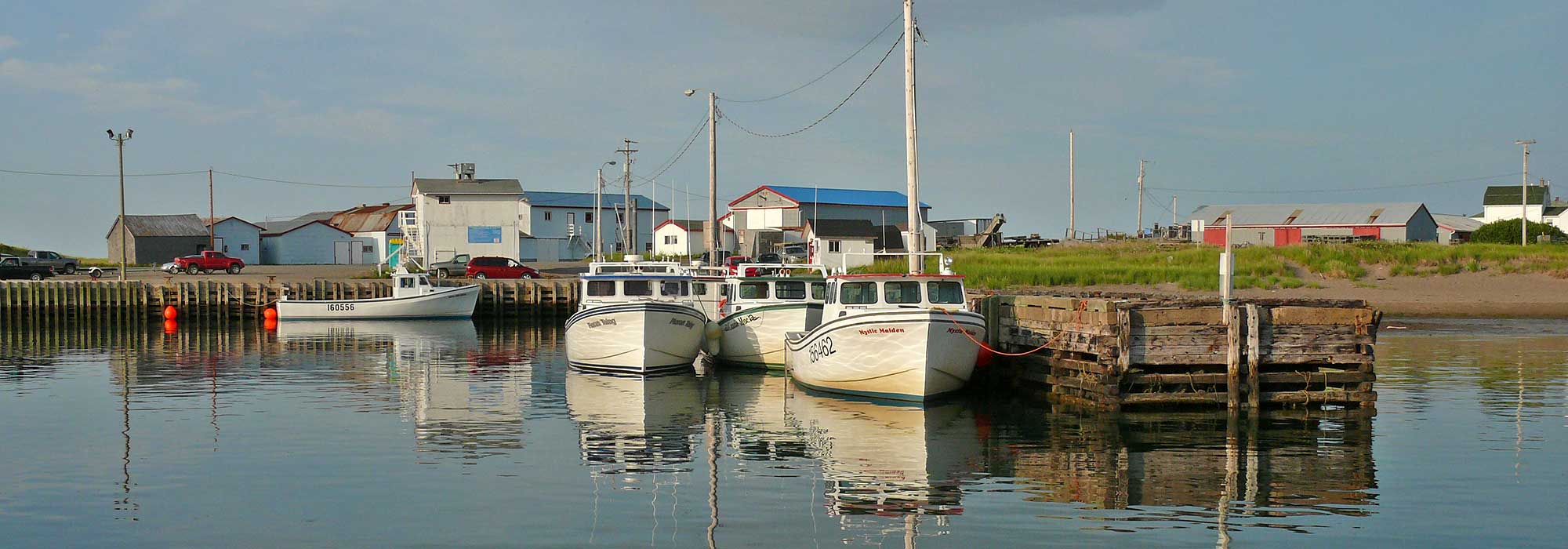
Visitor Information

Nova Scotia is located in Canada, on the upper east coast of North America, lying between the provinces of New Brunswick (in the west) and Newfoundland (in the northeast).
Explore Nova Scotia, from the Cabot Trail on Cape Breton Island, to Greater Halifax and Peggy's Cove, the famous tides of the Bay of Fundy, the rugged wilderness and pristine white sand beaches of the Eastern Shore, the orchards and wineries of the Annapolis Valley, to the lighthouses and Acadian culture of the South Shore.
How do I get there ?
Nova Scotia is easily accessable by Air, Sea or Land. An international airport is located just outside the capital city of Halifax. There is also an airport located in Sydney which services the island of Cape Breton. Several ferry services operate in Nova Scotia, offering connection to the surrounding Provinces of New Brunswick, Prince Edward Island and Newfoundland. Nova Scotia is connected to mainland Canada at the New Brunswick border. Travelling the Trans Canada Highway east from New Brunswick will enter Nova Scotia in the Amherst area... from here it is roughly a 2.5 - 3 hour drive to the capital city of Halifax. Passenger rail service is provided by VIA Rail, with stations in Truro and Halifax.
Visitor Information Centres
There are several Visitor Information Centres located throughout Nova Scotia, staffed by travel counsellors who will help you with travel information and literature (brochures, maps, guides, etc). Just follow the Question Mark ( ? ) signs!
I need more Information
Download your free Nova Scotia Travel Guide by clicking here . For more information please call: 1-800-565-0000 (within North America). If you are outside of North America, please call 1-902-425-5781 , or Email: [email protected] .
What else ?
Don't forget to Sign the Guestbook !
Enjoy your Vacation !
Explore Menu
- About Explore
- Destinations
- Accommodations
- Attractions
- Festivals & Events
- Photo Gallery
- Video Gallery
Explore Resources
- Travel Information
- Visitor Guestbook
- Submit Listing
- Advertise on Explore
- Link to Explore
- Related Links
- Contact Information
Explore Nova Scotia Tourism Guide, featuring Destinations , Accommodations , Attractions , Adventures and Music Festivals & Events .
© 2024 ExploreNovaScotia.com and Rivendell Software (E), All Rights Reserved » Privacy Policy .
Providing Nova Scotia tourism and travel information since 1996.
"Festivals & Events" and "Destinations" photos courtesy of Nova Scotia Tourism.
"Accommodations" banner photo courtesy of Anchorage House Inn & Cottages.
"Places to Stay" photo courtesy of Blockhouse Hill Bed & Breakfast.
"Things to Do" photo courtesy of Greg Trowse.
The 10 best things to do in Nova Scotia

Sep 22, 2022 • 8 min read
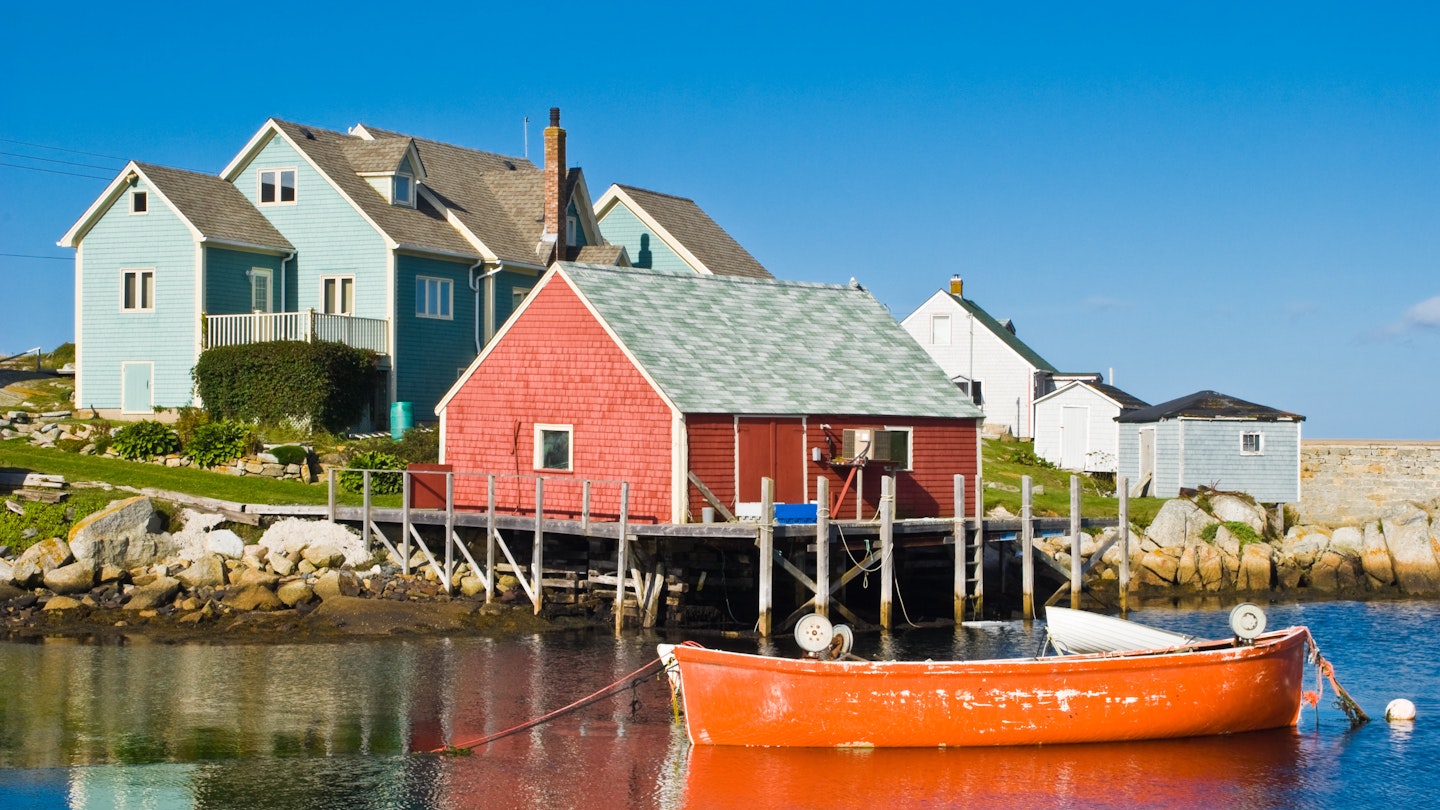
Nova Scotia is a slice of seaside heaven, perfect for those who seek adventure © DOPhoto / Shutterstock
The rugged and beautiful land that comprises what is now Nova Scotia has been inhabited by the indigenous Miꞌkmaq people for thousands of years – and today it’s an unforgettable destination to explore. Whether you’re looking for once-in-a-lifetime experiences, culinary trails or family-friendly attractions, this Maritime province has it all.
On the edge of the Atlantic, Nova Scotia offers up glowing sunsets and jaw-dropping scenery – which can be seen along its incredible winding coastal roads. This slice of seaside heaven is all about outdoor fun, so make sure to pack your sense of adventure...and a few layers.
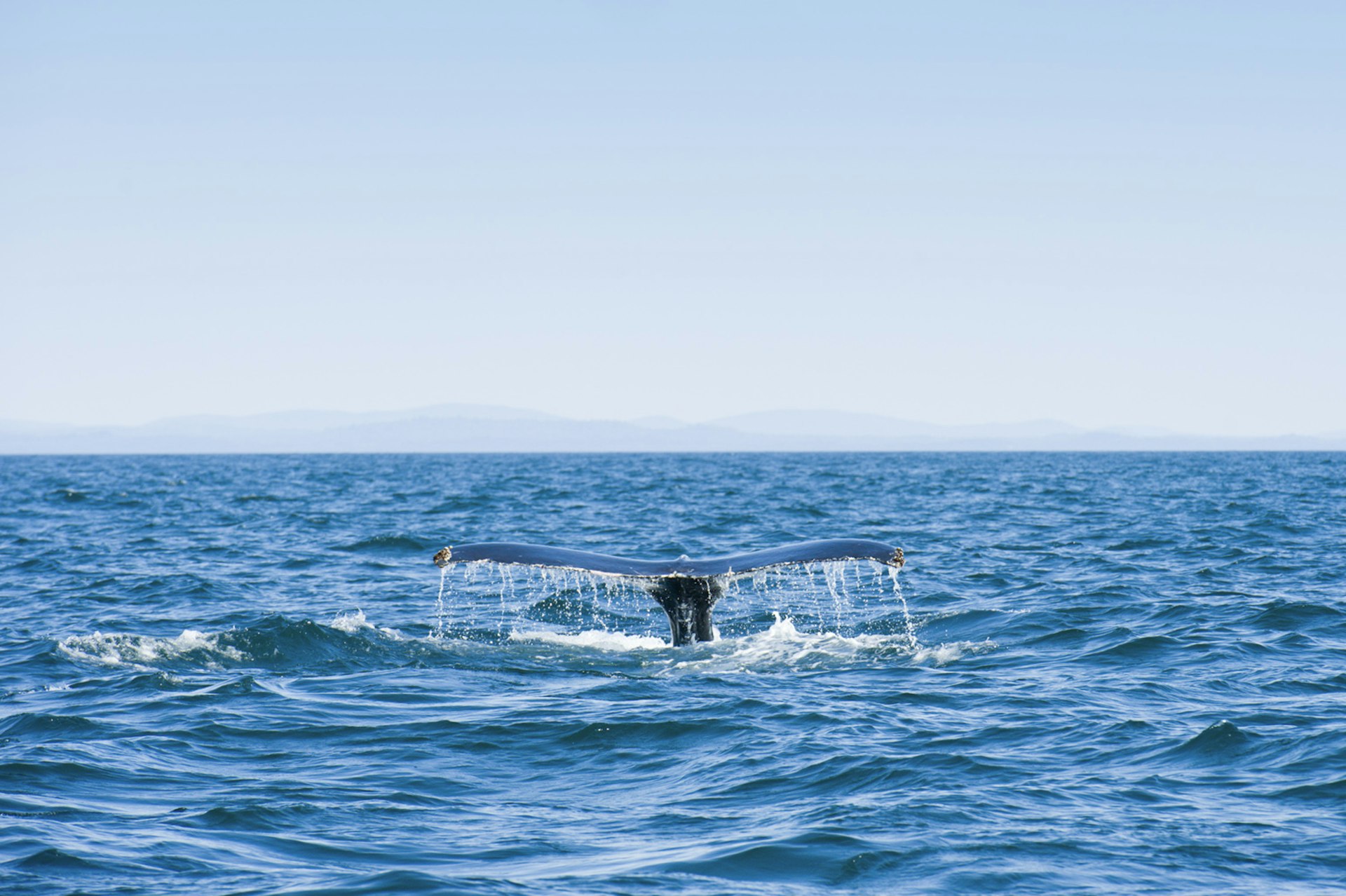
1. Feel the power of the Bay of Fundy
Located halfway between the equator and the North Pole, the Bay of Fundy is often on every list of best things to do in Nova Scotia. For good reason too. The highest tides on earth, the rarest whales in the world, semi-precious minerals and dinosaur fossils are all there to discover at this Natural Wonder of North America .
There are many ways to experience this phenomenal site beyond just pulling up for a quick roadside visit. Walk on the ocean floor at low tide at Burntcoat Head Park , where kids will enjoy examining ocean life in the tidal pools and exploring caves while parents gawk at the jaw-dropping scenery. Meanwhile, foodies will want to pre-book the Dining on the Ocean Floor experience for a unique full-day culinary experience that will never be forgotten.
Adventure seekers, get ready to immerse yourself in the Bay of Fundy tides with Tidal Bore Rafting . You’ll find yourself mud sliding before maneuvering the raft through the tidal waves.
Detour: If your kids are into dinosaurs, take them to the Fundy Geological Museum , which has exhibits on fossils found in the area.
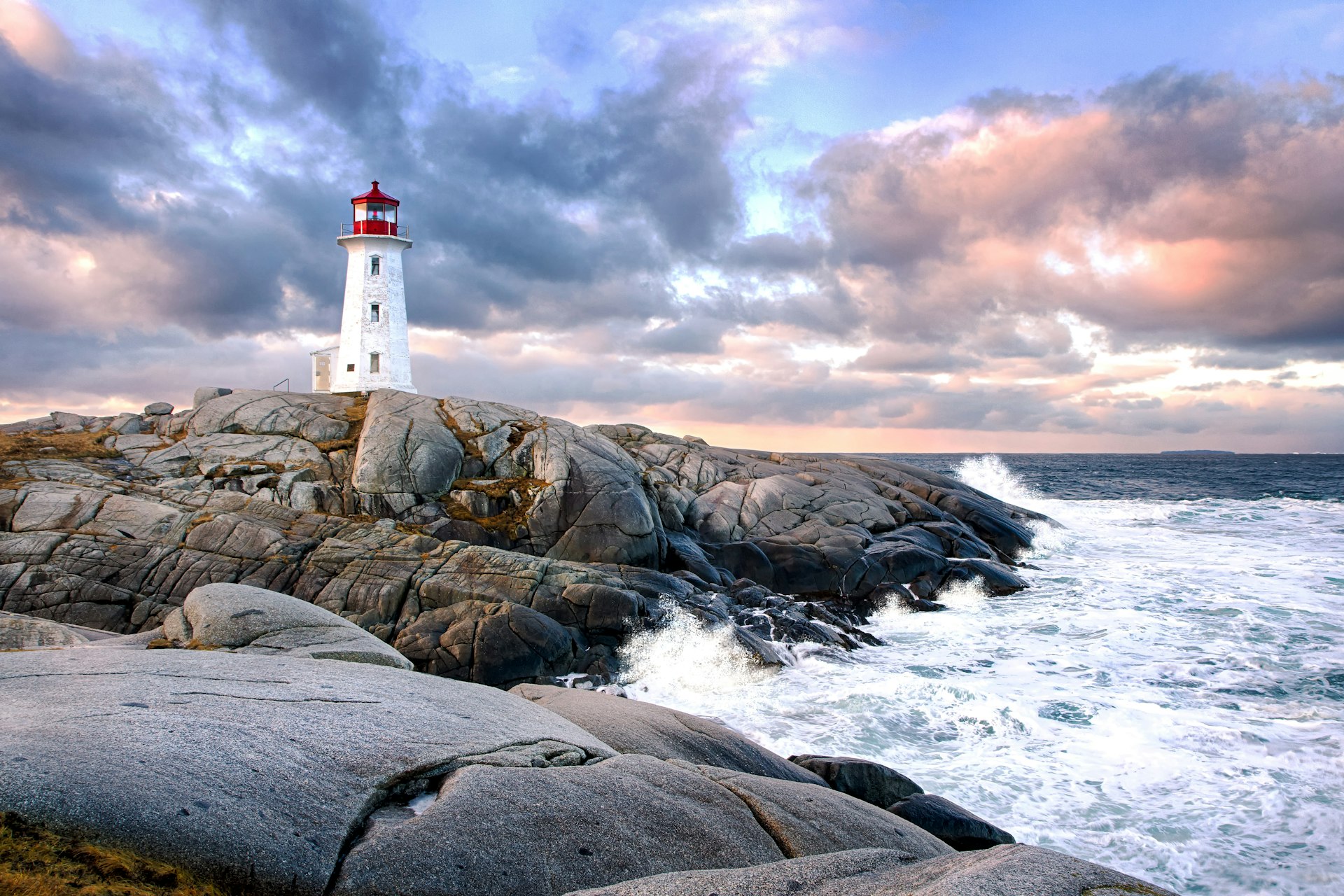
2. Go lighthouse spotting
With its rugged coastline, it should come as no surprise that Nova Scotia is home to the largest collection of lighthouses in Canada. Although Peggy’s Cove Lighthouse (also known as Peggy’s Point Lighthouse) is one of the best places to visit in Nova Scotia, there’s plenty more to explore as you roam around the province. Catch a sunset by Cape George Point Lighthouse , on a clear day you can see both Prince Edward Island and Cape Breton Island from atop the point. If you’re visiting the Fortress of Louisbourg , keep an eye out for the one there that replaced the original, which was lost during the famous battles between the French and the English. As you roam the coast, you’ll spot quite a few of the 170+ Nova Scotian lighthouses – and true fans will definitely want to pop in to the Out of the Fog Lighthouse Museum on Half Island Cove.
Read more: The 15 best free things to do in Halifax
3. Glamp under the stars
While there are numerous scenic trails and plenty of provincial and privately-owned campgrounds, not everyone is ready for the backpacker lifestyle. Luckily, Nova Scotia has plenty of glamping options even for those who seek the finer things in life.
True North Destination ’s 5-star eco-resort offers luxury domes that come with full bathrooms, kitchenettes and hot tubs. Mountain sunrises greet you each day and ocean sunsets will lull you to sleep. Archer’s Edge Luxury Camping , found on a cliff overlooking the Gulf of St. Lawrence near Judique, is a solid option for those looking for an adults-only Nova Scotia getaway. Valley Sky Luxury Camping lets you immerse yourself in the wondrous outdoors and natural beauty of Grand Pre and offers the finest of luxuries to complement the peace of mind that comes with a rural retreat.

4. Cruise the Cabot Trail
Undeniably, one of the best things to do in Nova Scotia is to drive the Cabot Trail. The trail navigates a 185-mile (298-kilometer) loop around most of Cape Breton Island , weaving throughout Cape Breton Highlands National Park . Whether you go clockwise or counterclockwise, spend a day or five, be sure to make time for the Alexander Graham Bell National Historic Site in Baddeck.
Stop to enjoy the vistas, taste the local flavors and sneak in a cèilidh (a traditional Scottish or Irish social gathering) if you can. The Acadian village of Chéticamp is a great spot to learn about hooked rugs and fiddle music. The Keltic Lodge Resort is a worthy resting spot and if you’re a golfer, you will want to swing by Highland Links, one of the top 100 courses in the world. Remember to pack your bathing suits if you’re visiting during the warmer months of July and August because there are many beaches on the Cabot Trail.
Planning tip: For more celtic experiences, be sure to visit during the Celtic Colours International Festival (October 7-15 in 2022). Book early; the festival attracts a ton of visitors from around the world and accommodation fills up fast.
Read more: Nova Scotia’s Atlantic coastline is a lobster lover’s paradise
5. Take a helicopter to an island picnic
Want to explore the romantic side of Nova Scotia? Take in the views from above with a heli-picnic experience . Board your helicopter at the Halifax Stanfield airport and take in a bird’s-eye view of the city of Halifax before soaring over turquoise waters towards secluded Sambro Island. Here your experience includes a private picnic and wine tasting with a sommelier on the island, which you have all to yourself.

6. Sip wine through the Annapolis Valley
Nova Scotia’s wine scene is ever-growing, and a responsible drive through one of the four wine regions will delight wine lovers looking to chat with vintners and sample the province’s Tidal Bay appellation. Of the four (Malagash Point, Annapolis Valley, Gaspereau Valley and the South Shore), Annapolis Valley offers a variety of easily navigable options.
Travelers can bike through Wolfville along the Harvest Moon Trailway and stop in for a tasting at Mercator Vineyards , try a few nibbles at Lightfoot & Wolfville Vineyards , snap a picture at Luckett Vineyards or eat a full meal at Domaine de Grand Pre ’s award-winning restaurant, Le Caveau.
Base yourself in Wolfville and check out the Grand Pre National Historic site, part of the UNESCO World Heritage Landscape of Grand-Pré. Whatever you choose, you can sip, savor and enjoy the succulent flavors found in this part of the province, often with idyllic water views of the incredible Bay of Fundy.
Planning tip: If you’d rather leave the driving to someone else, the Magic Winery Bus will take you on an official tour through one of the best places to visit in Nova Scotia, the Gaspereau Valley region.

7. Chow down on seafood
Nova Scotia is known for its fresh seafood, hearty chowders and scrumptious lobsters. On your East Coast trip, experience some seaside lobster boils, embark on the chowder trail, learn how to shuck oysters and get some tips from the local fishermen. Go down the lobster trail making your way to the Baddeck Lobster Suppers, grab some lobster tacos at Old Fish Factory in Lunenburg and obviously some Creamed Lobster at La Cuisine Robicheau . There’s also lobster beer and lobster fries to add to your list. Lobster everything!
Planning tip: There are several lobster festivals throughout the year including the Lobster Crawl Festival that takes place each February.
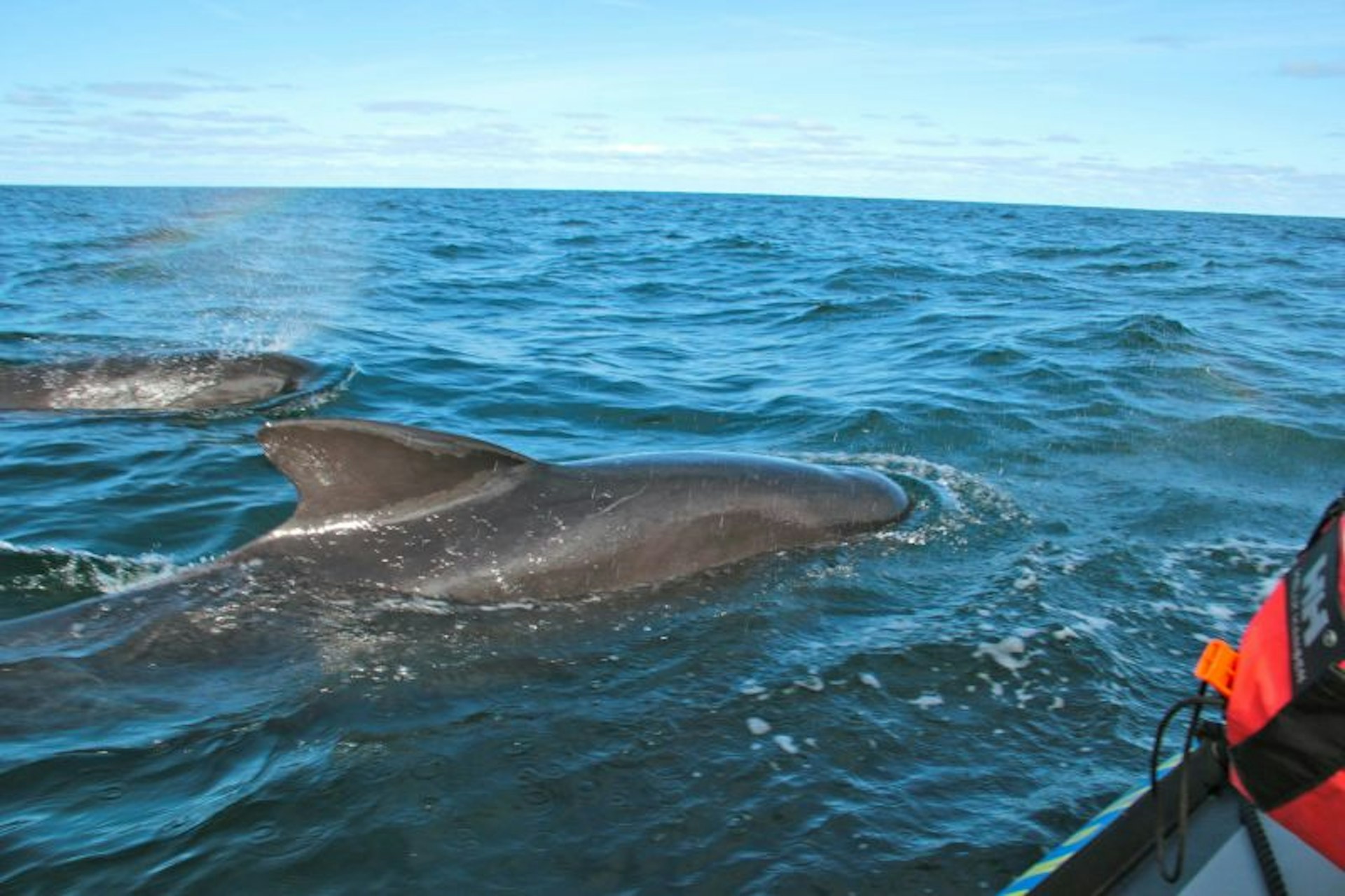
8. Dive into a whale-watching expedition
If you’re looking for unique things to do in Nova Scotia during the summer and fall, add whale watching to your Nova Scotia itinerary. The best way to see the magnificent whales in the Bay of Fundy or Northern Cape Breton waters is to join a Zodiac tour but be aware, the ride can get bumpy. If you’re looking for a smoother ride, the fishing-style boat tours are your best option. Get that camera ready because you never know when one of the 12 species of whales known to frequent the area each year might jump out in front of you.

9. Go stargazing
There are many places to stargaze in Nova Scotia and you’re guaranteed a mesmerizing experience when visiting the province. Spend the night at the world’s first Starlight hotel, Trout Point Lodge , for one of the best stargazing spots in North America. They even have onsite astronomers to help guests learn about the stars overhead.
Kejimkujik National Park and National Historic Site is a Dark Sky Preserve located less than 2 hours from Halifax. This makes it the perfect place to see shooting stars and constellations or a clear night. And for a truly educational visit, swing by the Deep Sky Eye Observatory for a guided tour and a peek through telescopes. They have sky cabins and sky bubbles here for those who want a complete overnight experience.
10. Head off in search of the best brews
With over 50 breweries to explore, you’ll have quite the time searching for your favorite Nova Scotian beer. Most brewmasters take pride in their work and are often nearby to answer questions about their locally sourced ingredients and craftsmanship, so don’t be shy.
Visit Big Spruce Brewing to enjoy their brewery farm and patio vibes as you sip on their classic Kitchen Party Pale Ale. Swing by Tatamagouche Brewing Company for some award-winning German-inspired Nova Scotian suds. Looking for something different? A classroom taproom awaits you at Schoolhouse Brewery! No matter what you’re in the mood for – sours, ales, IPAs, stouts – you’ll find your perfect brew in Nova Scotia.
This article was first published Aug 30, 2021 and updated Sep 22, 2022.
Explore related stories
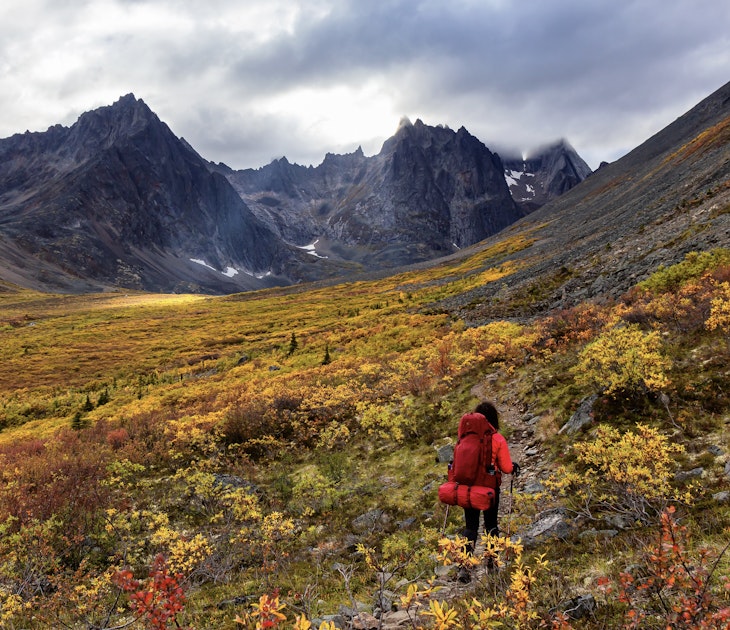
Apr 15, 2024 • 12 min read
The best way to take in Canada’s awe-inspiring landscapes? On your own two feet. Consider starting with these 16 hiking trails all over the country.

Jan 30, 2024 • 19 min read

Jan 22, 2024 • 7 min read

Jan 5, 2024 • 20 min read

Jul 3, 2023 • 8 min read

Jan 5, 2023 • 14 min read

Dec 7, 2022 • 10 min read

Jan 19, 2022 • 6 min read

Dec 18, 2021 • 7 min read
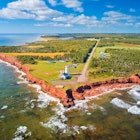
Dec 9, 2021 • 3 min read

17 Top-Rated Attractions & Places to Visit in Nova Scotia
Written by Chloë Ernst and Lura Seavey Updated Sep 26, 2022
Pretty and peaceful, Nova Scotia is Canada's second smallest province, a peninsula on the eastern edge of the Canadian mainland. But its lengthy coastline is dotted with fishing harbors, sandy beaches, plump islands, and other beautiful places to visit. The scenery varies greatly, from the foggy Atlantic Ocean in the southeast to the tidal salt marshes of the Bay of Fundy in the west and Gaelic highlands of Cape Breton to the north.
In these maritime latitudes, Nova Scotia has a pleasantly breezy if rather damp climate. Summer is bright and sunny, but weather conditions can often cause fog, with snow in winter.
Halifax is the capital and largest city. In 1604, the French, including Samuel de Champlain, settled the Annapolis Valley, founding Port-Royal , the first lasting European settlement north of Florida. They called it Acadia, a name that is now used to refer to all French settlement in the Maritimes.
Find the best places to visit in this fascinating province with our list of the top attractions in Nova Scotia.
1. Cabot Trail
2. peggy's cove, 3. fortress of louisbourg national historic site, 4. cape breton highlands national park, 5. halifax citadel national historic site, 6. maritime museum of the atlantic, 7. kejimkujik national park, 8. halifax harbour, 9. lunenburg, 10. canadian museum of immigration at pier 21, 11. annapolis royal historic gardens, 12. halifax public gardens, 13. shubenacadie provincial wildlife park, 14. grand pre national historic site, 15. port-royal national historic site, 16. hall's harbour, 17. ross farm museum, map of attractions & places to visit in nova scotia.
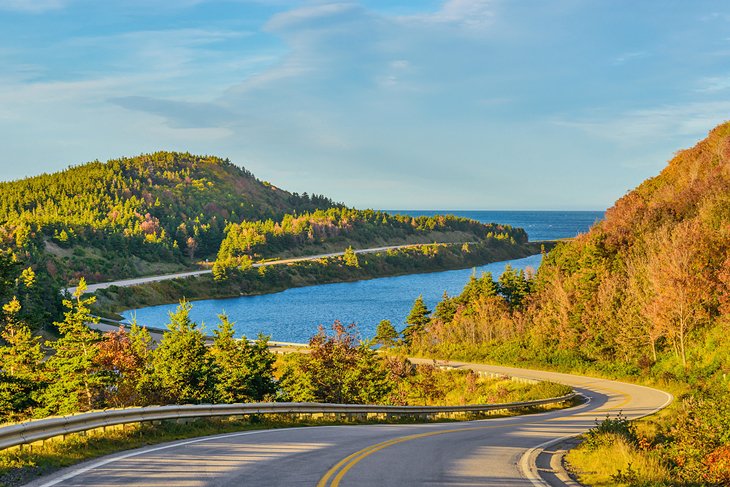
A 300-kilometer scenic drive rings the northwest coast of Cape Breton Island and Cape Breton Highlands National Park. It is a coastal route, where the highest mountains in Nova Scotia dramatically meet the Gulf of St. Lawrence . Cliffs, beaches, viewpoints, and a twisting road give countless photo opportunities, and this is a very popular motorcycle tour route.
Many small communities and tourist attractions line the route, including a variety of local artisans and unique shops. Hiking is one of the popular things to do. There are also many excellent hiking trails, and tourists can either hike on their own or hire a local guide to show them the best spots.
Cabot Trail unofficially begins and ends in Baddeck, home to the father of the telephone, Alexander Graham Bell. Autumn is a favorite time to drive the Cabot Trail owing to the region's vibrant fall colors.
Location: Cape Breton Island, Nova Scotia
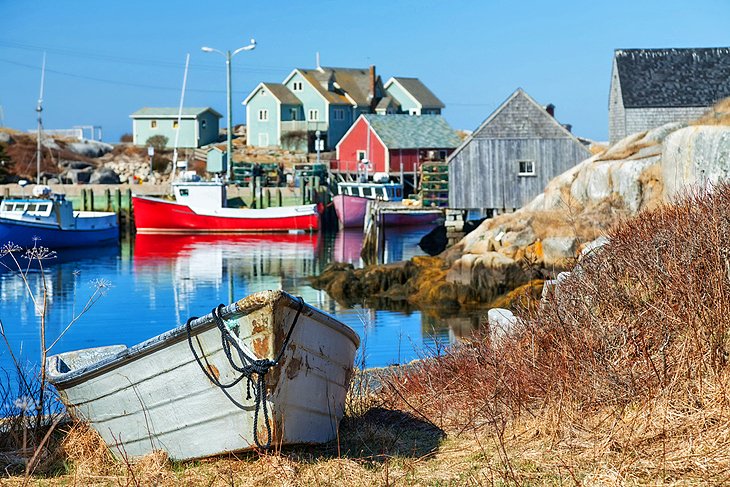
About 43 kilometers southwest of Halifax, the fishing village of Peggy's Cove has a back-in-time feel. Peggy's Point Lighthouse, one of Canada's most photographed lighthouses, sits on the foggy Atlantic Coast marking a perilous point. Stark, wave-battered granite bluffs surround the lighthouse, and tourists should exercise extreme caution if exploring the rocky shoreline.
Fishing wharves and boathouses line the shore of this active fishing community, and colorful heritage homes and art galleries line the winding road. Among these is the deGarthe Gallery and Museum , home to a fine collection of the work of local artist William E. deGarthe, a Finnish immigrant who was inspired by Peggy's Cove and its fishermen at a young age.
Tourists with some time to spend exploring the area can take a self-guided sightseeing tour of the Coastal Heritage Trail , which has been described as a "museum without walls." Top destinations include the Peggy's Cove Preservation Area, Pioneer Cemetery, Bishop's Park, and many other historically significant sites like the SS Atlantic Heritage Park .
The park includes a museum with many artifacts and information about the tragic demise of the ship and its crew, as well as a nice boardwalk and a memorial.
This is an extremely popular day-trip destination from Halifax, so be prepared for crowds of tourists, especially near the lighthouse.
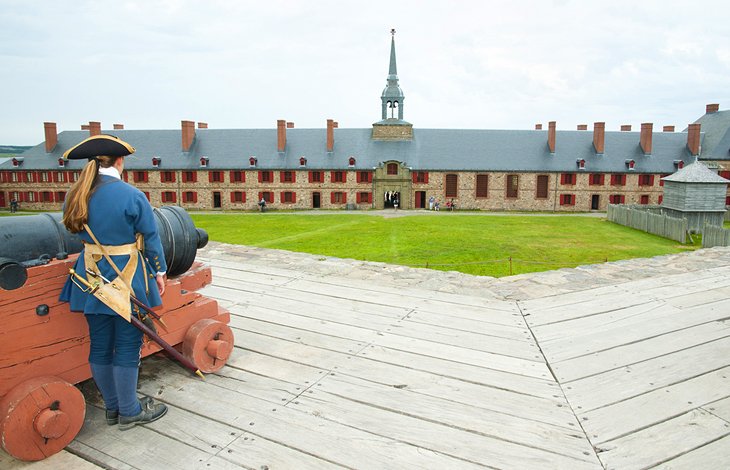
The Fortress of Louisburg National Historic Site is a living history museum, which recreates mid-18th century fort life with more than forty historic buildings, costumed guides, and working establishments. Rebuilt on the site of a 1713 French fort, enormous defensive walls surround the town, some of which were up to 35 feet thick when constructed.
The reconstructed site is now filled with a cast of costumed interpreters who go about daily life, from domestic to military. Visitors can watch servants cook and taste authentic hot chocolate and fresh baked bread, see the merchants hawk their wares, and feel the ground shake as soldiers fire the cannon and their muskets.
Tourists looking for a more immersive experience can choose to spend the night here in a reproduction tent or period home - a truly unique experience for couples looking for a memorable romantic getaway.
Address: 259 Park Service Road, Louisbourg, Nova Scotia
Official site: www.pc.gc.ca/en/lhn-nhs/ns/louisbourg
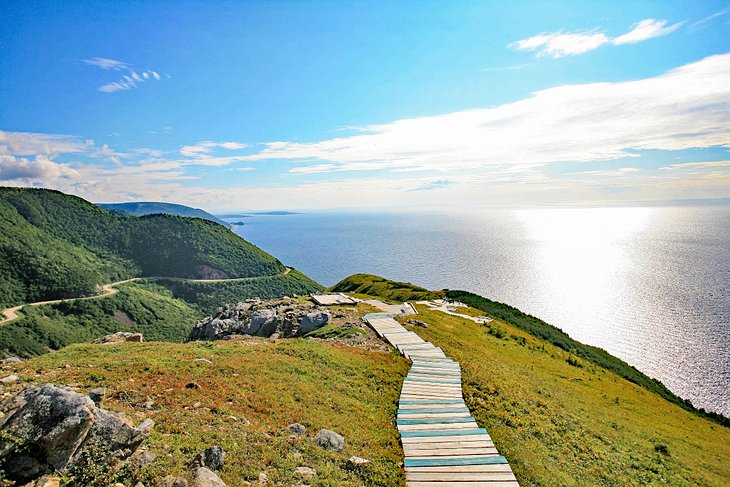
The highest peaks in Nova Scotia are in Cape Breton Highlands National Park, which covers more than 950 square kilometers at the northern tip of Cape Breton Island . Both the coastline of beaches and cliffs and the inland forests and rivers tempt hikers, campers, and families to explore the park.
Wildlife watching is excellent in the national park, with moose, beaver, eagles, and deer often visible from the Cabot Trail scenic drive, which partially cuts through the park.
The park is also home to Skyline Trail , a scenic route laid out in an easy-to-walk wooden boardwalk path. Overlooking the Gulf of St. Lawrence, visitors can spot whales below while enjoying panoramic views of the rugged coastline.
The small Acadian town of Chéticamp lies just outside park boundaries. It is well worth a stop for its small shops and galleries and dining establishments. It is also home to Les Trois Pignons , a unique museum and visitor center that houses a good collection of antiquities and traditional hooked rugs.
Official site: www.pc.gc.ca/en/pn-np/ns/cbreton/
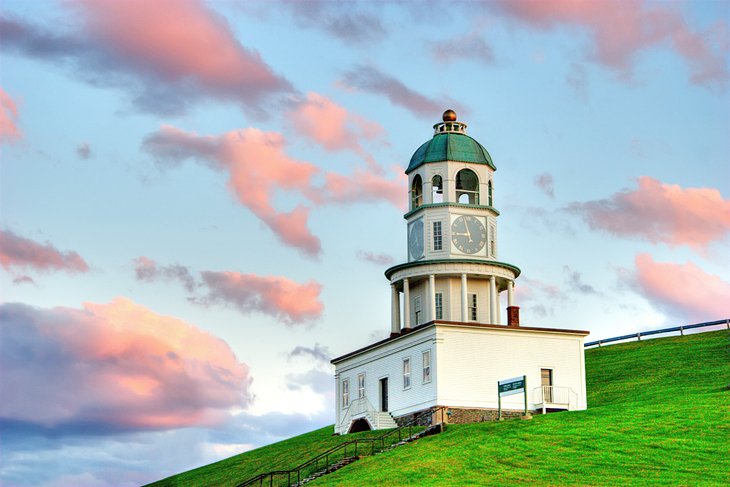
Overlooking downtown Halifax, this hilltop fortress is the remnant of a British garrison that was first established in the 18th-century. Halifax Citadel National Historic Site, which itself was built in 1856, never saw a battle.
Today, the warren-like tunnels, powder magazine, and barracks have been preserved, and living-history guides give tours. There are reenactments and fortress guards with interpreters dressed in British reds, complete with musket salutes and the sound of bagpipes.
The road leading up Citadel Hill is popular for its city and harbor views, and it passes the Old Town Clock , which Prince Edward commissioned in 1803.
Address: 5425 Sackville Street, Halifax, Nova Scotia
Official site: www.pc.gc.ca/en/lhn-nhs/ns/halifax
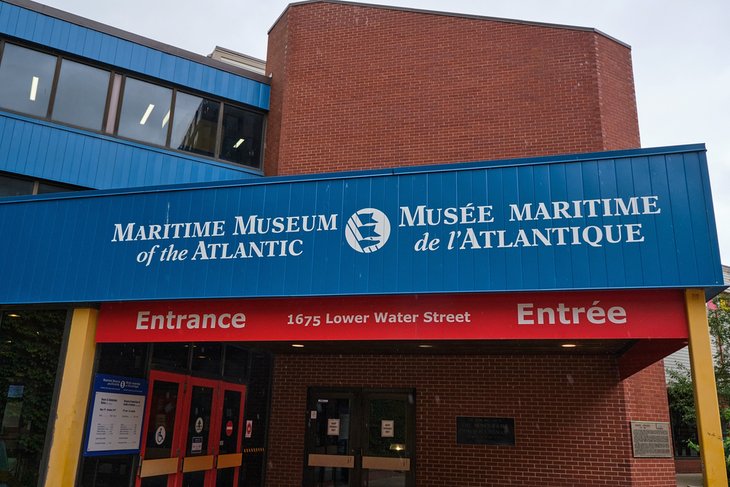
The exhibits and displays at this museum bring the maritime history of the province and the North Atlantic to life, showing visitors the role the sea has played in all facets of local life. Using photographs and personal tales of survivors, excellent multi-media exhibits chronicle the 1917 collision of two ships in the harbor, which caused the Halifax explosion.
Museum collections include more than two hundred model ships, from old sailing craft to ocean liners, freighters, and naval ships. Another part of the museum is in an old ship chandlery, where items were bought to outfit ships for sea.
There is also an extensive exhibit on the recovery efforts after the Titanic sank, Halifax being instrumental in rescue operations. On display are items found on the sea during rescue and later recovered, telling the tale of the ship and the people on board.
Also part of the museum are several craft moored in Halifax Harbour, including Queen Victoria's Royal Barge, a gift to the museum by Queen Elizabeth II. Another historically significant ship is the HMCS Sackville , a corvette class known for bouncing around like a cork in heavy seas, which saw duty during the Battle of the Atlantic in the convoys that kept Britain alive.
CSS Acadia is also open for touring as part of museum admission; it's now retired after long years of service in the Arctic and North Atlantic, charting the ocean floor.
Address: 1675 Lower Water Street, Halifax, Nova Scotia
Official site: https://maritimemuseum.novascotia.ca
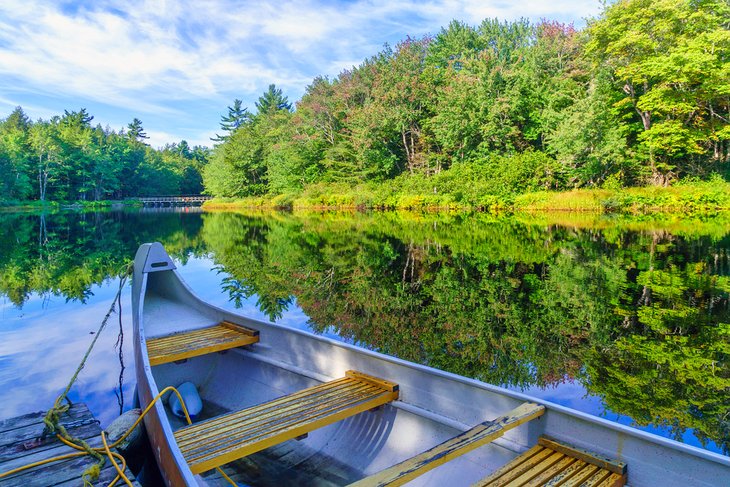
Kejimkujik National Park occupies nearly 400 square kilometers of inland Nova Scotia, with a small seaside adjunct that has a stunning white-sand beach.
One of the biggest draws to this peaceful space is the rich history of the Mi'kmaw people who occupied the land for millennia. Visitors can still see evidence of Mi'kmaw life in the numerous petroglyphs, and learn more about native culture by watching Mi'kmaw craftsman Todd Labrador build birchbark canoes using traditional methods.
The majority of the park is only accessible by hiking or by canoe, making it an excellent place to truly get away. Campsites are located throughout the park for those who want to be completely immersed in nature, or visitors can enjoy the area during the day by hiking or paddling traditional Mi'kmaw routes.
Address: 1188 Saint Catherines River Road, Port Joli, Nova Scotia
Official site: www.pc.gc.ca/en/pn-np/ns/kejimkujik
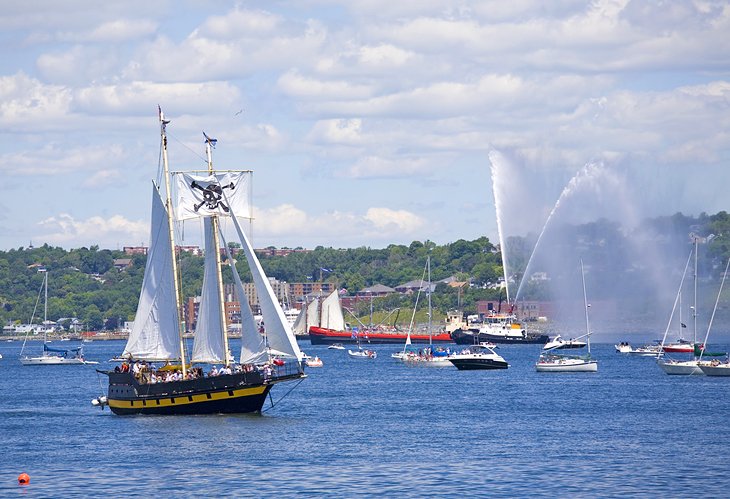
A boardwalk lines the Halifax Harbour, leading from the Canadian Museum of Immigration at Pier 21 to the Maritime Museum of the Atlantic and restaurants. Tugs, sailboats, and navy vessels come and go, and the views look out to Dartmouth across the harbor and Georges Island mid-channel.
This is where you will find the ferry to Dartmouth, as well as plentiful choices if you want to take a sightseeing cruise in the harbor or go whale-watching. Near the ferry terminal, you can find a group of restored heritage buildings and a pedestrian area, which is lively both day and night, full of restaurants that often feature live maritime bands and always offer the freshest of seafood.
Tourists will find more shopping and plenty of goodies to snack on at the Halifax Seaport Farmer's Market , founded in 1750, making it the oldest farmers market in the Americas. The market is open daily and features locally grown, caught, and hand-made items including prepared food.
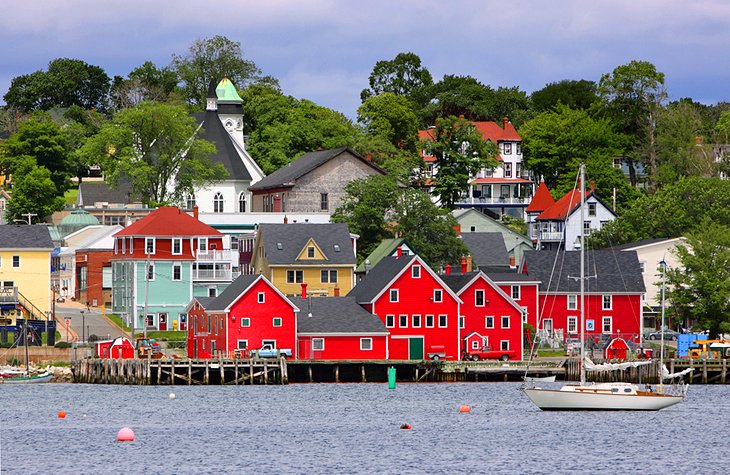
Brightly colored heritage buildings dot the hilly Lunenburg townscape, nearly three-quarters of which are the original structures from the 18 th and 19 th centuries. Many of these have been turned into inns and bed-and-breakfasts, and the community is a UNESCO World Heritage Site .
Lunenburg's legacy was established when it became an early shipbuilding center. The town's most famous craft is the Bluenose schooner. Built here in 1921, the boat won many international races before sinking off the coast of Haiti. A replica, Bluenose II, is often in port, while other fishing vessels and a schooner can be seen at the Fisheries Museum of the Atlantic.
Along the waterfront, the port is still alive with vessels docking at the wharves and fishermen unloading the catch of the day.
- Read More: Top-Rated Things to Do in Lunenburg & Mahone Bay, NS

At one time, Pier 21 was the Canadian equivalent to Ellis Island, welcoming twenty percent of the nation's immigrants from 1928 through 1971. Through permanent and changing exhibits, visitors can find out what it was like to travel across the ocean and arrive in a new country.
Many of the exhibits are hands-on, including the chance to actually dress in period costumes, go inside a replica ship, and explore the contents of trunks and crates to learn more about the lives of the immigrants who packed up their most valued possessions.
The museum also has extensive genealogical resources at the Scotiabank Family History Centre , where anyone can go to trace their own family's immigration history free of charge.
Address: 1055 Marginal Road, Halifax, Nova Scotia
Official site: https://pier21.ca/
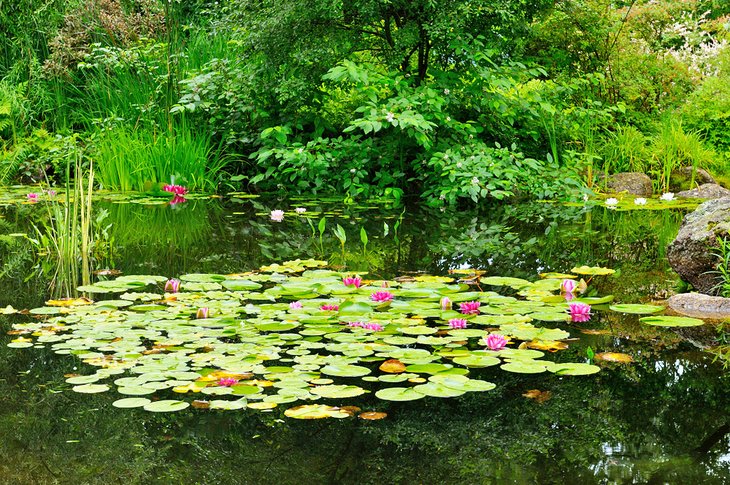
The Annapolis Royal Historic Gardens is one of the finest show gardens in North America, with 10 acres of beautifully planned and expertly executed historical and horticultural beds. The Rose Garden has two thousand bushes set among paths with green lawns, and the Governor's Garden is planted in the style and with the plants of the 1740s.
In a separate section are demonstration plots for current techniques and plants, and there is a winter garden where the plants are chosen for a bark, stem shape, or form that makes them attractive in the winter.
On the back side of the garden, the path looks out over the banks of the river. The gardens are a popular place for weddings, so you may have to sidestep around a happy couple and beaming parents.
Another top historic attraction in Annapolis Royal is the Fort Anne National Historic Site, originally built by the French in 1643 and taken over by the British in the 1750s. While the only remaining buildings are an 18 th -century gunpowder magazine and officers barracks, the impressive walls and ramparts are substantially intact.
Address: 441 St. George Street, Annapolis Royal, Nova Scotia
Official site: www.historicgardens.com
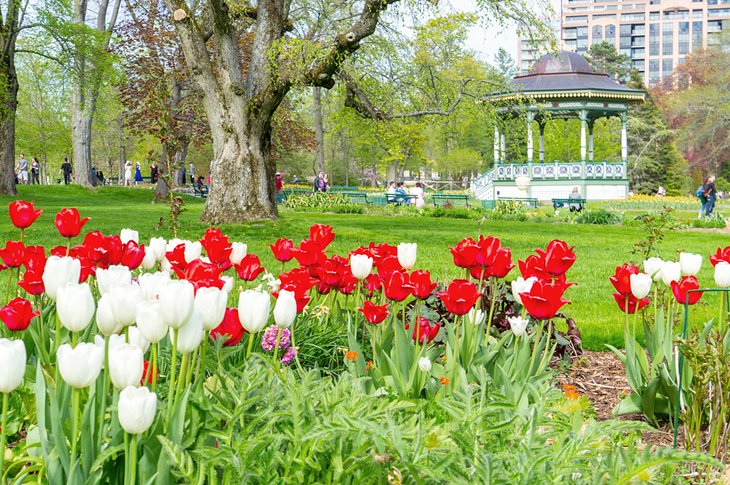
The Halifax Public Gardens are the oldest Victorian gardens in North America, created in 1867 and now an official National Historic Site. Tourists can enjoy an hour-long guided tour of the gardens, which reveals its historic and horticultural significance. The gardens are free to visit and often host both public and private events.
In the spring, the gardens are bright with beds of tulips, daffodils, and irises, and the magnolia and cherry trees are in full bloom. June brings azaleas and rhododendrons, and later in the summer, dahlias, peonies, and roses line the artfully laid-out paths.
Even into November, you will find a variety of color, although the Friends of the Public Gardens Information Desk and park café close at the end of October.
Address: 5665 Spring Garden Road, Halifax, Nova Scotia
Official site: www.halifaxpublicgardens.ca

Located 40 kilometers from Halifax, Shubenacadie Provincial Wildlife Park makes an excellent day trip. The park is spread over 40 hectares and is home to a wide variety of native and exotic animal species, including moose, foxes, beavers, wolves, black bears, and cougars. Visitors can interact with many of the park residents by feeding the animals grains provided in dispensers throughout the park.
Horse fanciers take note: the park is the only wildlife park in the world with Sable Island horses .
The park is also home to a variety of birds, including over a dozen species of pheasant and fowl, raptors including the bald eagle, peregrine falcon, and great horned owl, and even emu.
Address: 149 Creighton Road, Lake Egmont, Nova Scotia
Official site: https://wildlifepark.novascotia.ca/
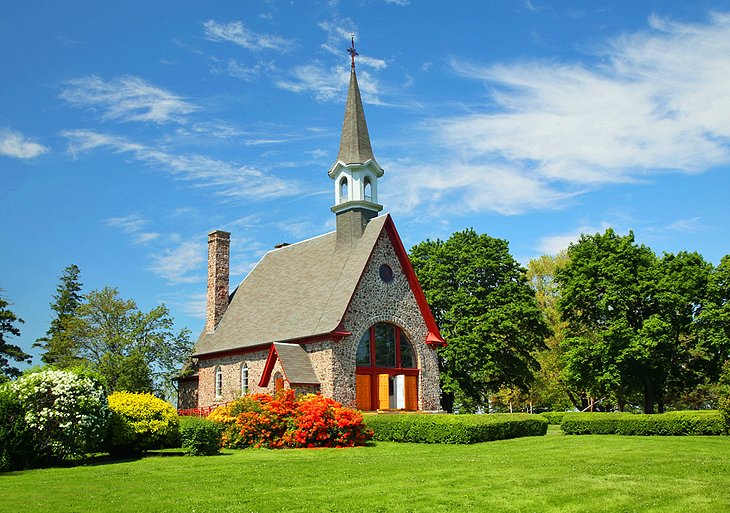
Acadians settled in Grand Pre in the early 18th century, reclaiming Bay of Fundy salt marshes for agricultural land through a series of dykes. But as Nova Scotia changed hands between the French and British, it brought unrest to the region. When the French-speaking Acadians refused to swear allegiance to England in 1755, the British deported about 10,000 people and destroyed their farms.
Grand Pre National Historic Site is a memorial to this injustice. Pretty gardens, a small chapel, and a statue of Henry Longfellow's fictional heroine Evangéline are part of the picturesque grounds at the historic site.
Official site: https://www.pc.gc.ca/en/lhn-nhs/ns/grandpre
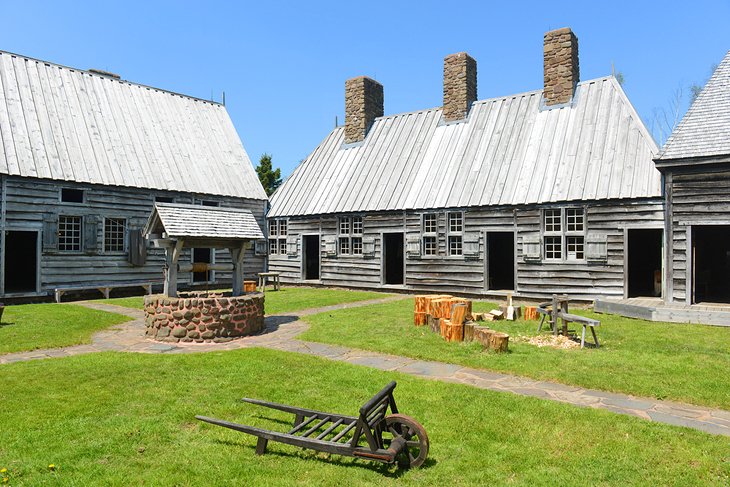
Port-Royal National Historic Site in the Annapolis Valley is where, in 1605, Sieur des Monts founded one of the first permanent settlements in North America and established a fur-trading center.
Though the British later destroyed the fort, it has now been rebuilt using authentic 17th-century building techniques. The complex includes a Governor's Residence, a fur trading post, and priest's quarters, as well as a reproduction of the original quadrangle named the Habitation.
Living-history interpreters give insight into the settlers' struggle to survive, including how the native Mi'kmaq helped the Europeans through their first hard winters. Visitors can interact with the interpreters and ask questions, and there is also a special hands-on learning program for kids ages 6-11.
Address: 53 Historic Lane, Port Royal, Nova Scotia
Official site: www.pc.gc.ca/en/lhn-nhs/ns/portroyal
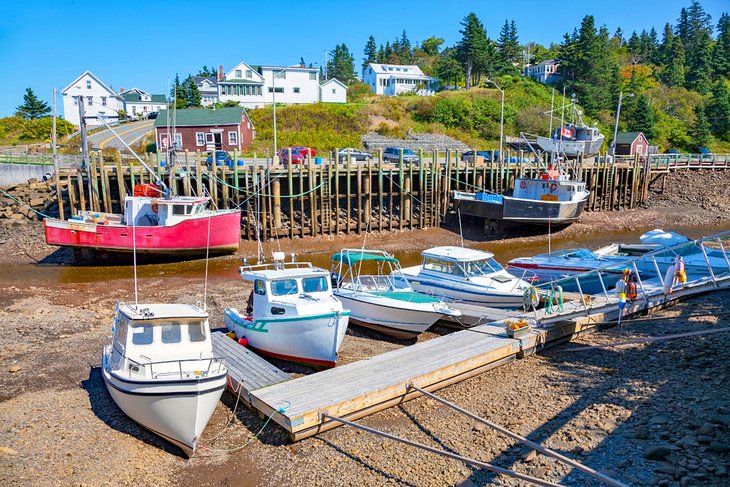
Though it's lesser publicized than New Brunswick, the Nova Scotia side of the Bay of Fundy shares claim to the highest tides in the world. Hall's Harbour is not the pinnacle of that tidal range (head instead to the Minas Basin ), but it is one of the prettiest, with a wide sandy beach and wharves where docked fishing boats act as tidal markers. At low tide, the vessel sits on the harbor bottom.
A seafood restaurant is the main destination in the tiny village. From Hall's Harbour, other Annapolis Valley attractions are nearby, including The Lookoff viewpoint near Canning, Cape Split hiking trails , and Blomidon Provincial Park .
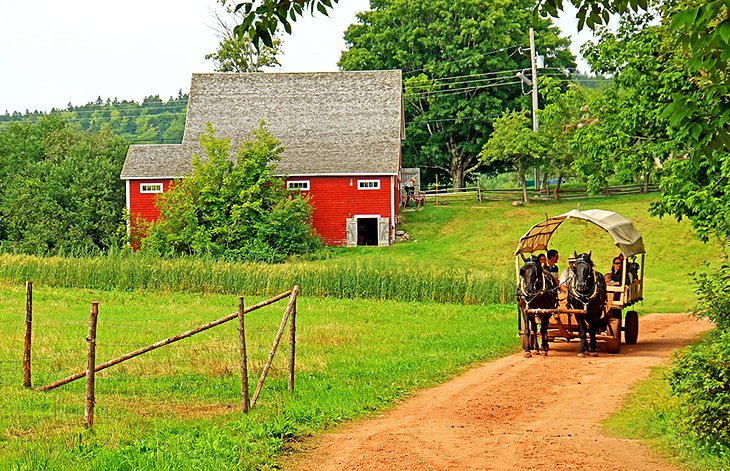
Ross Farm Museum does an excellent job of representing a working farm from more than 150 years ago. Numerous displays and buildings take visitors through a time warp to a bygone era. The 60-acre farm is, in fact, a real working operation, with a dairy barn, oxen pulls, and wagon rides.
Visitors can see a variety of animals including Canadian horses, oxen, various types of poultry, Southdown and Cotswold sheep, along with Berkshire Pigs. There is a nature trail that allows visitors to stroll throughout the property, along with a blacksmith's shop, cooper's shop, barn, schoolhouse, and the original Ross cottage.
Address: 4568 Highway 12, New Ross, Nova Scotia
Official site: http://rossfarm.novascotia.ca/

More on Canada
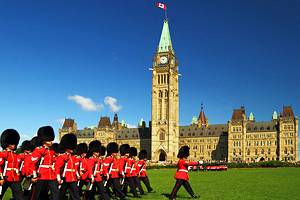
Nova Scotia

- 3 Other destinations
- 4.1 Tourist information
- 5.1 By plane
- 5.4 By boat
- 5.5 By train
- 12 Stay safe
Nova Scotia is one of Canada 's Atlantic Provinces . With around 950,000 inhabitants, it is one of the least populated. For visitors, Nova Scotia offers beaches, history, rugged wilderness parks, a mix of Celtic, Acadian French, and Indigenous cultures. As a peninsula exposed to the Atlantic Ocean, Nova Scotia has a more maritime climate than mainland Canada, with mild winters and cool summers.
Regions [ edit ]

Cities [ edit ]
- 44.647778 -63.571389 1 Halifax — capital of the province and economic and cultural hub of Eastern Canada. There's history to explore, culture, beaches and friendly laid-back East Coast hospitality.
- 44.6667 -63.5667 3 Dartmouth — the "City of Lakes" across the harbour from Halifax.
- 45.3917 -61.5083 4 Guysborough — an attractive seaside town with a lighthouse museum and an excellent harbour
- 44.376111 -64.309167 5 Lunenburg — historic fishing village with the brightly painted houses and picturesque townsite. UNESCO World Heritage Site.
- 45.681389 -62.711944 6 Pictou — the birthplace of new Scotland has many old buildings to see, an attractive waterfront and several museums
- 46.1378 -60.1829 7 Sydney — largest city on Cape Breton Island and close to the ferry to Newfoundland
- 44.980278 -64.129167 8 Windsor — the "birthplace" of hockey
- 43.836111 -66.1175 9 Yarmouth — a good base for exploring the inland wilderness areas, with over 365 lakes and several major rivers
Other destinations [ edit ]
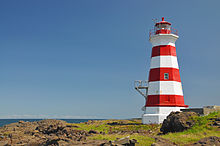
Understand [ edit ]
For a population just under a million Nova Scotia is remarkably diverse: Mi'kmaq, Scots descendants, black Nova Scotians, French Acadians, Annapolis Valley farmers, Cape Bretoners and Haligonians all form distinct groups with their own unique quirks, culture and language. The novel "Rockbound" is written entirely in the South Shore dialect of the fishermen of that region, a fusion of Shakespearean English, German and unique local idioms.
Champlain named Nova Scotia "Acadie" and claimed it for France in 1604. French immigrants settled the area and became prosperous farmers and fisherman. However, they were expelled by the British in the mid 18th century, with their lands, especially on the South Shore, repopulated with "foreign Protestants", meaning mostly Dutch and Germans. Many areas still retain a strong Acadian French culture, including the largest Francophone municipality, Clare in Digby County and Argyle, in Yarmouth County. Nova Scotia hosted the World Acadian Congress in 2005. The Louisiana "Cajun" is a slang adaptation of "Acadien" in the French. Longfellow's poem "Evangeline" celebrates the victims of the expulsion, as does Zachary Richard's drum and voice song "Reveille". Because of the expulsion, French is far more commonly heard in New Brunswick.
Nova Scotia received 3,500 Black Loyalists, who were evacuated by the British from the United States between 1776 and 1785. Shelburne was a main landing spot.
Halifax, the capital, is one of the oldest cities in North America and was a critical sea link during World Wars I and II. The infamous "Halifax explosion" caused by collision of two ships in Halifax Harbour in 1917 was the worst man-made explosion on Earth until Hiroshima in 1945.
Halifax today is an education and high technology centre, with over a dozen post-secondary institutions including Dalhousie University and substantial operations by major high-technology firms. Academics have unusual influence in Nova Scotia, perhaps because of their concentration in the capital.
Unless you are a winter surfer, or like to snowshoe, then it is probably best to visit Nova Scotia sometime between June and October, when the weather is warm, the skies are blue and the water may be less frigid. The main byways are along the coast, and a lot of small shops and restaurants are open around the coast during the summer months. Watch out for mosquitoes and horseflies in the summer, however, especially after a storm.
Tourist information [ edit ]
- Nova Scotia Tourism website
Get in [ edit ]
By plane [ edit ].
Robert L. Stanfield International Airport ( YHZ IATA ), at Halifax , is the main international airport in the province.
By car [ edit ]
Near Amherst , Route 2 in New Brunswick crosses into Nova Scotia becoming Highway 104. Route 2 and Highway 104 is part of the Trans-Canada Highway . It is roughly a three-hour drive from Moncton to Halifax and 3.5 hours from Charlottetown to Halifax.
By bus [ edit ]
By boat [ edit ].
Ferry service is available from:
- Wood Islands , Prince Edward Island to Pictou , Crossing time is 75 minutes. Connects Highway 1 (in Prince Edward Island) and Highway 106 (in Nova Scotia), which are both part of a branch of the Trans-Canada Highway .
- Saint John , New Brunswick to Digby
- Port aux Basques , Newfoundland and Labrador to North Sydney . Crossing time is 7 hours. Connects Highway 1 (in Newfoundland) to Highway 105 (in Nova Scotia), which are both part of the Trans-Canada Highway.
- Argentia , Newfoundland and Labrador to North Sydney. Crossing time is 16 hours. Operates from June to September.
- Bar Harbor , Maine in the United States of America to Yarmouth
By train [ edit ]
Get around [ edit ].
Nova Scotia has a comprehensive road network, with three tiers of highways:
Highway 104 on mainland Nova Scotia and Highway 105 on Cape Breton for the Trans-Canada Highway . Highway 102 connects Highway 104 with Halifax . Together, Highway 102, 104, and 105 form the backbone of the road network connecting most of the province's main centers with New Brunswick and the ferries to Newfoundland . Highways 101 and 103 connect Yarmouth to Halifax via the Annapolis Valley (Hwy 101) and the South Shore (Hwy 103).
The provincial tourism department has created a number of scenic routes that cover specific geographic regions of the province, such as the Lighthouse Route along the South Shore or the Glooscap Trail that covers the Minas Basin region. The routes are generally well sign-posted and good to explore if you want to focus on a specific region in-depth.
If driving, be aware of road conditions in the winter, especially away from major areas.
Park Bus connects Halifax to Kejimikujik National Park.
See [ edit ]

Peggys Cove Lighthouse , 35 km SW of Halifax on road 333 is one of Canada's more renowned landscape scenes. It is a lighthouse on rounded rocks. There is a restaurant and tourist information, but otherwise it is just big rocks with a dozen small houses and 60 people living there. Outside Peggys Cove on the 333 there are plenty of B&Bs and restaurants. The Swissair Memorial , close to Peggys Cove on the 333, commemorates a 1998 aircraft disaster.
The Cape Breton Highlands provide a profoundly beautiful drive along the Cabot Trail any time of the year but it is most pristine in Autumn, once the leaves change.
Bras d'Or Lake (pronounced 'bre-dor', an inland sea within the island of Cape Breton).

The Cape George Lighthouse , on the northeastern mainland coast, near Antigonish provides incredible views.
Citadel Hill in downtown Halifax is a fortification dating from the first half of the 19th century; it is called the 'Warden of the North'. Downtown Halifax is a compact historic city with some interesting sites.
The Southern Nova Scotia Biosphere includes the Tobeatic Wilderness Area and Kejimikujik National Park in the southern half of the province. Together they form the largest protected wilderness area in Atlantic Canada.
The Fortress of Louisbourg National Historic Site on Cape Breton Island is the largest reconstructed 18th-century French fortified town in North America.
Do [ edit ]
For fossil collectors , there are many beaches along the shores of Cape Breton Island that have exposed coal seams and rocks containing fossilized ferns and other flora can be found in these areas.
During the Tall Ships Festival , Halifax hosts up to 30 historic and unique (and usually massive) maritime sailing vessels from around the world.
Whale-watching tours are popular in towns along the Atlantic coast.
Tidal Bore Rafting is a unique way to experience the highest tides in the world near Truro.
Victoria Park is a 400-hectare park in Truro with wooded trails, swimming pool, picnic areas, waterfalls, ball field, playground, and outdoor stage.
Hike the Trans Canada Trail in Nova Scotia.
Sports [ edit ]
The province has several major teams in a variety of professional sports leagues, including hockey, box lacrosse, and soccer, as well as many teams affiliated with local universities operating in the Atlantic University Sport and Atlantic Collegiate Athletic associations.
- Halifax Mooseheads , in the Quebec Major Junior Hockey League, who play at the Scotiabank Centre in Halifax from October through March.
- Cape Breton Screaming Eagles , also in the Quebec Major Junior Hockey League, who play at Centre 200 in Sydney from October through March.
- Halifax Thunderbirds , in the National Lacrosse League, who also play at the Scotiabank Centre in Halifax from December through June.
- Halifax Wanderers FC , in the Canadian Premier League, who play at the Wanderers Grounds in Halifax from April through October.
Eat [ edit ]
Berries : having so much of the province in a natural state, there are many opportunities to pick wild fruit and berries. There are wild strawberries in the fields and along roads, wild blueberries, raspberries and cranberries (in coastal areas). Blueberry grunt is a blueberry baked with a sweet dumpling topping.
Deep fried pepperoni : a bar snack often dipped in honey mustard sauce.
Dulse : most of this seaweed is harvested at very low tides in parts of Nova Scotia. Locally it is dried and used as a snack.
Garlic fingers : similar to a pizza in shape and size and made with the same type of dough. Instead of the traditional tomato sauce and toppings, garlic fingers consist of pizza dough topped with garlic butter, parsley, and cheese, cooked until the cheese is melted. Bacon bits are sometimes added. They are typically eaten as a side dish with pizza and often dipped in donair or marinara sauce. They are presented in thin strips (or "fingers") as opposed to triangular slices.
Halifax donair : a pile of roasted, spiced beef (known as donair meat) with diced tomatoes and white onions covered in condensed milk sauce and wrapped in a pita. It is unique to the province and is available at almost every corner diner and pizzeria.
Hodge podge : a creamy soup of fresh baby vegetables; rarely found in restaurants.
Lobster rolls are common throughout the province.
Digby Scallops : local seafood which is highly recommended by literature and locals.
Drink [ edit ]
The legal drinking age in Nova Scotia is 19, and establishments commonly ask for a government-issued ID from anyone who looks under 30. It is illegal to buy alcohol for the purpose of consumption by a minor. There are penalties for operating a motor vehicle with a blood alcohol level above 0.05, and alcohol must be unopened if in a vehicle, or otherwise stored in the trunk. Consumption of alcohol in public locations such as parks is also illegal, and is subject to a $467.50 fine.
The sole distributor of alcohol and recreational cannabis in the province is the Nova Scotia Liquor Corporation, which operates 108 stores across the province, primarily attached to grocery stores such as Sobeys. There are four private retailers in the Halifax area who sell beer, wine, and spirits. There are 65 agency stores in rural areas of the province which operate privately as alcohol vendors on NSLC's behalf.
Nova Scotia produces some very good wines. Most wineries offer free tours. Of particular note is Jost Winery along the Northumberland Strait north of Truro.
Try the local beers. Nova Scotia is best known as the home of "Alexander Keith's India Pale Ale", known locally as "Keith's". But there are many lesser known brews available as well. Not to be missed are the offerings of Propeller Brewery and Garrison Brewing in Halifax , as well as several microbreweries and brewpubs.
Sleep [ edit ]
Due to the increasing popularity of the area, there are several options of accommodation to choose from. Especially in the rural areas one should rather expect smaller B&Bs than international hotel chains.
As in most places, there are great differences between season and off-season, both in price and availability. Many places close during winter (late October/early November until March/April).
Stay safe [ edit ]
In case of emergency, dial 911. Be aware that it can sometimes take over half an hour for an ambulance to arrive.
In rural areas, cell coverage can be weak or unavailable, so inform people of your destination and plans ahead of time.
Seat belts are mandatory for drivers and all passengers. Helmets are required by law for all motorcycle and bicycle riders.
Radar detectors are illegal and will be confiscated if found by the RCMP.
If you are hiking in grassy areas you should be aware that Lyme Disease is present in Nova Scotia and carried by ticks, which are abundant in the spring. Tie your pant legs or pull your socks over your pant legs and watch for ticks.
If hiking in the woods, carry a radio at all times and make lots of noise as you walk, which lowers the chance of a surprise encounter with an animal. Never go out into the wilderness alone. Be alert and aware of your surroundings at all times and stay on marked paths. If camping, secure all your food in air-tight containers or leave it in your vehicle, and burn all your scraps. NEVER feed a wild animal.
Though rare, several attacks on humans by coyotes have occurred, particularly in rural areas of Cape Breton and the Cape Breton Highlands National Park. If you encounter a coyote, maintain eye contact, wave your arms and shout, and throw rocks at the animal. Do not ever run away from a coyote.
Go next [ edit ]
- Ferries leave for Newfoundland from North Sydney .
- Ferry service to Maine runs from Yarmouth .
- New Brunswick and Quebec can be reached in a day's drive on the Trans-Canada Highway
- Prince Edward Island (PEI) can be reached via ferry from Caribou Wharf near Pictou , or via the Confederation Bridge from New Brunswick .
- Has custom banner
- Has mapframe
- Maps with non-default alignment
- Maps with non-default size
- Has map markers
- Guide regions
- Guide articles
- Region articles
- Has Geo parameter
- Atlantic Canada
- All destination articles
- Pages with maps
Navigation menu
Welcome to Cape Breton Island on Canada’s Atlantic Coast
There’s something about this place that captivates all who visit. Cape Breton Island tells its story through rugged cliffs and the trails that crisscross its landscape, in the languages of its people, and through the music and dance celebrating centuries of culture. Here, the profound history of Unama’ki—its true name and the ancestral land of the Mi’kmaw People—comes alive.
From the warm Mi’kmaw “Pjila’si” to the Gaelic “Cíad Míle Fáilte” and the French “Bienvenue,” Cape Breton Island is a cherished home to a lucky few and a beloved destination for many. Welcome to a place where every corner invites discovery and every view tells a story. Welcome to Cape Breton Island, where there’s truly something remarkable about this place.

#1 Island in North America
Cape Breton Island has been ranked the #1 Island in North America by Condé Nast Traveler readers and #1 Island in Canada by Travel + Leisure readers. These awards honour the top travel destinations and companies around the globe.
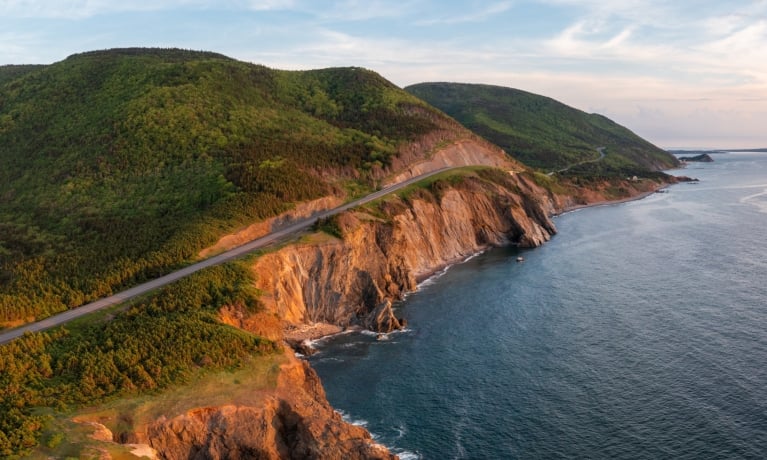
Cabot Trail
Rising from the sea and clinging to mountains, the 298-kilometre-long Cabot Trail is a winding mix of roadway, paths, stairs and stunning beauty that takes you from unreal ocean vistas to quaint fishing villages.

Things To Do
Not just another pretty place. Here, you’ll find a lifetime of adventure packed on our 110-mile long Island.

Waterfall Season
Embrace the adventure, and let the pristine beauty of these cascading wonders awaken your spirit.

Take a picture. Leave your heart. #VisitCapeBreton
Locals Know Blogs

Cape Breton Island's Epic Winter Bucket List
Read through and see how many places, views, and experiences you can check off from this Epic Winter Bucket List!

4 Winter Days Along the Cabot Trail
Join Ashley MacDonald, one of our Adventure Ambassadors, on an outdoor adventure along the Cabot Trail. If you enjoy skiing, snowboarding, snowshoeing or just the sound of nature, you'll enjoy this blog!

7 Places for great Winter Eats
It’s time to find the heartiest, homemade meal on Cape Breton Island this winter. Our Island offers many options to chase away the chill.

5 Ingredients for a Snowmobiling Getaway!
Are you a fan of snowmobiling? Then you'll love our 5 top ingredients for snowmobiling around the Island.

7 Unique Places to Stay This Winter
Many marvel at the breathtaking views Cape Breton has in the summertime, but have you ever truly appreciated unwinding in our gorgeous winter? These snowy escapes could become your new favourite way to recharge this season.

Easy to Find. Hard to Leave.
There are direct flights to Sydney from Toronto and Montreal and from other North American and European cities via those cities. If traveling by ground, the Trans-Canada Highway 104 leads to Cape Breton Island.
Nomadic Matt's Travel Site
Travel Better, Cheaper, Longer
Nova Scotia Travel Guide
Last Updated: November 10, 2023

That welcoming atmosphere — combined with over 100 beaches, picturesque lighthouses, fresh seafood, and endless rugged coastline — makes visiting Nova Scotia an exciting (and underrated) destination in Eastern Canada.
Outside the capital city of Halifax, Nova Scotia is dotted with tiny fishing villages and coastal towns. Drive further north, and you’ll hit scenic Cape Breton Island which comes alive with vivid fall foliage each year along its Cabot Trail. In short, Nova Scotia is a province perfect for road trips.
Another bonus: Nova Scotia doesn’t see nearly as many tourists as the country’s larger cities, making it a somewhat off-the-beaten-trail destination that’s much more affordable than many of the more popular cities in Canada.
This travel guide to Nova Scotia can help you plan your trip, save money, and make the most of your visit to this beautiful east coast province!
Table of Contents
- Things to See and Do
- Typical Costs
- Suggested Budget
- Money-Saving Tips
- Where to Stay
- How to Get Around
- How to Stay Safe
- Best Places to Book Your Trip
- Related Blogs on Nova Scotia
Top 5 Things to See and Do in Nova Scotia
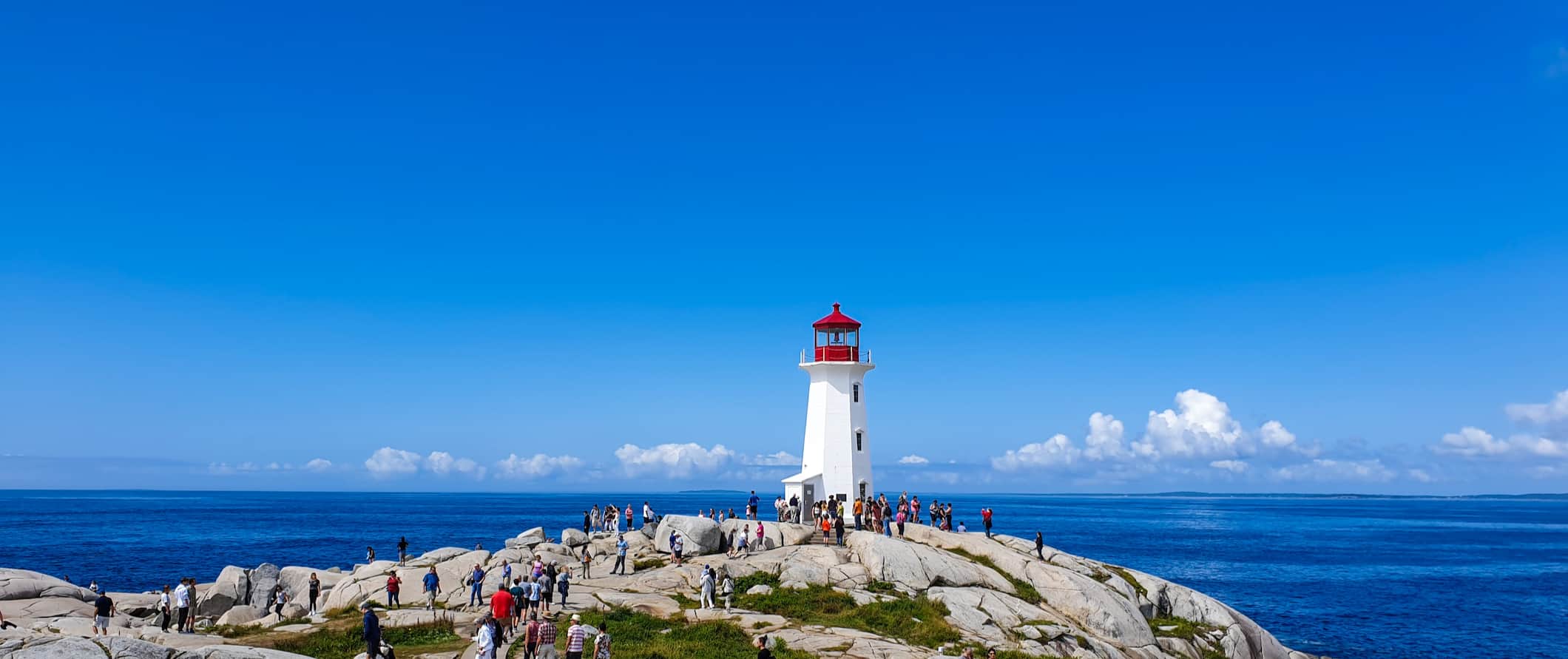
1. Hike the Skyline Trail
The Skyline Trail is easily the most popular hike in Cape Breton Highlands National Park. It stretches 6.5 kilometers (4 miles) through thick forest and then along the coast to reach a viewing platform overlooking the ocean. It’s a breathtaking walk on which you might even encounter moose. The hike is suitable for all levels and takes between 1.5-3 hours. Make sure to bring your own water, good shoes, and clothing layers as the weather can change quickly. The most popular time to visit is July, August, and September but many people come to see the autumn leaves change in October. Park admission is 8.50 CAD.
2. Tour the Alexander Keith’s Brewery
Alexander Keith is a legend in Nova Scotia. He opened his brewery in 1820, became mayor of Halifax, and was so wildly popular that Halifax throws a massive birthday party for him on the waterfront every October. Today, the 200-year-old brewery is one of the oldest in North America. Take a tour of the Halifax brewery to learn more and sample some of the limited edition beers at “Stag’s Head” pub at the end of the tour. Tours are 29.95 CAD.
3. Hang out in Halifax
Halifax is Nova Scotia’s cool capital city. It’s home to half a dozen universities so it has a lively nightlife, a thriving music scene, and countless trendy restaurants and craft breweries. Stroll the waterfront boardwalk, grab a lobster roll, and spend the evening at a local pub. Take the ferry over to Dartmouth across the harbor, known as ‘Halifax’s Brooklyn’ and check out the live music at New Scotland Brewing Company. The city has a youthful, arty vibe and is worth visiting for a couple of days.
4. Visit Peggy’s Cove Lighthouse
There are some 170 lighthouses in Nova Scotia, but Peggy’s Cove Lighthouse is the most famous. Once you see it, you’ll understand why it’s one of the most photographed lighthouses in the world. It’s a quintessential red-topped lighthouse standing on a rocky shore overlooking the Atlantic. Walk around and enjoy the ocean views and snap some photos. Beware: rogue waves are common, even on calm days. It’s possible to reach the lighthouse via bus and taxi but it is much easier by car.
5. Drive the Cabot Trail
Other things to see and do in nova scotia, 1. go tidal bore rafting in shubenacadie.
The Shubenacadie River’s rapids in the Bay of Fundy are powered by the highest tides in the world. One minute you’re floating down a peaceful river keeping an eye out for bald eagles and other wildlife and the next minute the river turns into a raging, foaming mass of rapids. When the tide changes twice a day, the tidal bore temporarily reverses the flow of the river, resulting in this wild river ride. A four-hour tour includes the guided rafting excursion, safety flotation gear, extra mud sliding on request (yes!), and post-rafting showers for when you need to clean up. Make sure to bring an extra clean change of clothes as well as a towel. A four-hour rafting trip starts at 95 CAD.
2. Go whale watching
In the summer and fall, 12 species of whales visit the waters around Nova Scotia, including pilot whales, minke whales, giant humpbacks, and the endangered North Atlantic right whale. There are tons of whale-watching tours to choose from in the area, with most operating outside of Halifax. Mariner Cruises takes you out for a 2.5-hour boating tour for 50 CAD departing from Westport on Brier Island, while larger groups like Lunenburg Whale Watching Tours start at 70 CAD.
3. Enjoy summer on the water
Summer is short in Nova Scotia, so when the weather is nice and the sun comes out, Nova Scotians hit the water to go sailing, kayaking, paddle boarding, and canoeing. Surfing is also big here, with Lawrencetown Beach being one of the more popular areas to find the biggest waves. Go swimming at Melmerby Beach or take a kayak around Kejimkujik National Park. Kayak rentals cost around 25 CAD for two hours or 32 CAD for the entire day.
4. Wander the Annapolis Royal Historic Gardens
Spanning 17 acres of greenery, these historical gardens overlook a tidal river valley and include an enormous rose collection (best seen in July) as well as an 18th-century Governor’s Garden and a 19th-century Victorian Garden. You can check out the reconstructed 1671 Acadian House or grab a coffee and light lunch at The Elm Tree Café (seasonal). It’s 16 CAD to visit except November to April when there is only a suggested donation of 5 CAD as the Gardens are not maintained during the winter months.
5. Visit the Alexander Graham Bell Historic Site
This museum in Cape Breton is host to a rich collection of artifacts and documents chronicling the life and career of Bell, the inventor of the telephone. The collection was accumulated by his family during their time here in Baddeck, Cape Breton. In the parlor, you can see Bell’s personal effects, like his favorite jacket, notebook, and walking stick. You can also take a behind-the-scenes “White Glove Tour” of the artifact storage facilities. The site is open May-October and admission is 8.50 CAD (13 CAD for the white glove tour).
6. Explore the Highland Village Museum
Over the centuries, the Canadian Maritimes have been heavily influenced by Scottish and Irish immigration. This outdoor pioneer museum and Gaelic culture experience highlights that history. The 43-acre site overlooking Bras d’Or Lake includes historic buildings like three frame houses, a mill, and a forge. You can take part in a traditional céilidh dance, hear Gaelic singing, and even practice a little of the language yourself. It’s open from June to October and costs 11 CAD.
7. Tour the Maritime Museum of the Atlantic
This museum depicts Nova Scotia’s maritime history with exhibits on boatbuilding, World War II convoys, the Titanic, and the Halifax Explosion (a huge disaster that happened in 1917, when two ships carrying ammunition ran into each other and destroyed much of the city). It’s a very comprehensive overview of the region’s history. Admission is 5.15 CAD from November-April and 9.55 CAD from May-October.
8. Visit nearby New Brunswick or Prince Edward Island
These two provinces are close to Nova Scotia and can be visited as day trips (or multi-day trips) if you have your own vehicle. Don’t miss New Brunswick’s Fundy National Park to see the world’s highest tides. In P.E.I., you can soak up some tranquility on the sea (and eat lots of seafood) and visit the Anne of Green Gables house.
9. Explore Lunenburg
Lunenburg is one of the most colorful towns you’ll ever come across. With its narrow streets and colonial 18th- and 19th-century buildings painted in bright hues of pinks, oranges, and greens, you’ll feel like you’ve stepped back into the past. There are still tall ships in the harbor and even an operational blacksmith hammering away on the waterfront. The harbor is home to the famous Bluenose II, a replica schooner of the original Bluenose boat that’s featured on the Canadian dime (ten-cent coin). The Bluenose was a famous fishing/racing schooner that went undefeated in her 18-year run and is an iconic part of Canadian history.
10. Tour the Canadian Museum of Immigration at Pier 21
If there’s just one museum you visit in Halifax, make it this one . Pier 21 was the immigration point for one million newcomers to Canada between 1928 and 1971. You’ll learn about 400 years of Canadian immigration history through first-person stories, archival photos, artifacts (including trunks and personal treasures), and digital documentation. Exhibits are incredibly interactive and you can even research your family’s pre-1935 immigration records from all ports of entry in North America. Admission is 15.50 CAD.
11. Relax in Kejimkujik National Park
For a taste of Maritime nature, come to this national park to paddle, hike, camp, and relax. Here you’ll find ancient rock carvings (petroglyphs), canoe routes, and coastal wilderness punctuated with sandy beaches and wildlife. To learn more about the Mi’kmaq people who traditionally have called the region home, join a storytelling session, take a guided petroglyph tour, or participate in a canoe-building workshop. Admission to the park is 6.25 CAD.
For more information on other destinations in Canada, check out these guides:
- Calgary Travel Guide
- Montreal Travel Guide
- Ottawa Travel Guide
- Quebec City Travel Guide
- Toronto Travel Guide
- Vancouver Travel Guide
- Vancouver Island Travel Guide
Nova Scotia Travel Costs
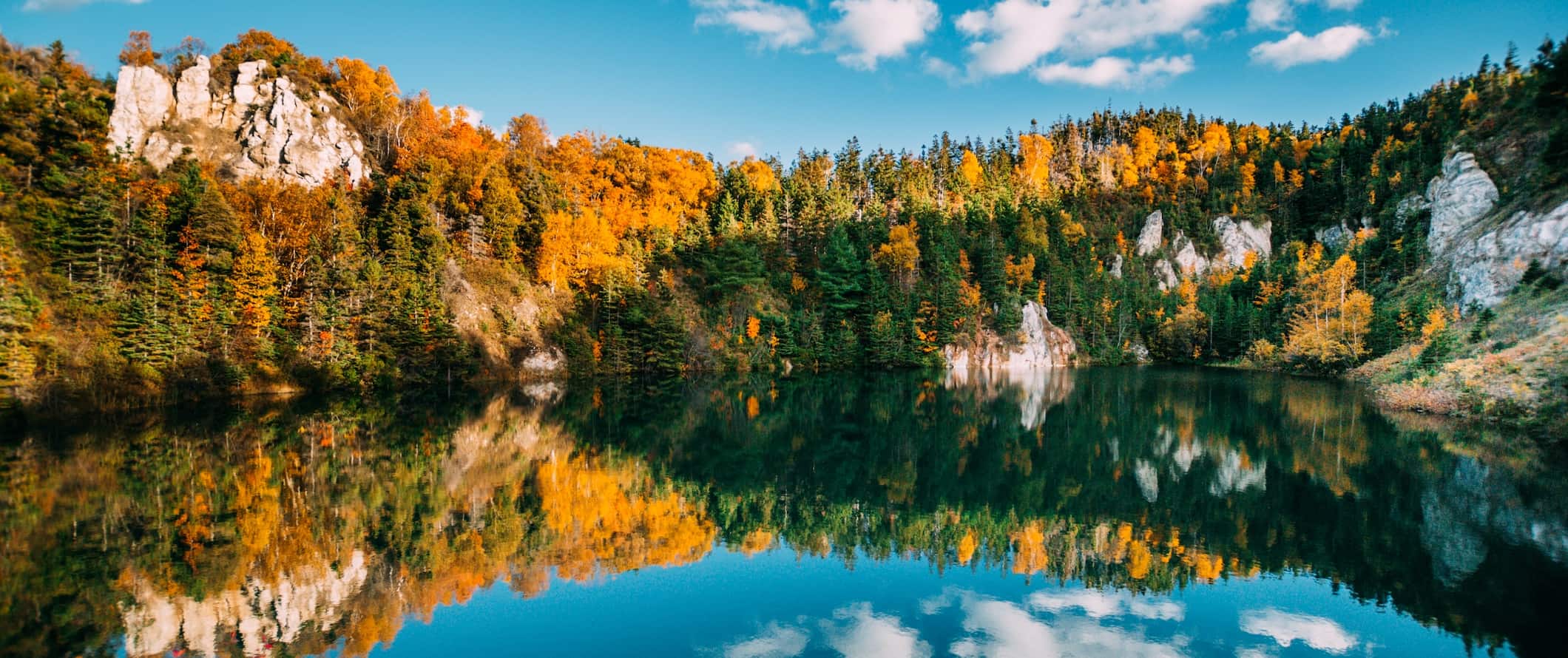
Hostel prices – Hostels are virtually non-existent in Nova Scotia. The only exception is Halifax. A bed in a 4-6-person dorm costs 30-35 CAD per night. A private room costs about 78-90 CAD per night. Expect basic amenities like free Wi-Fi and self-catering facilities.
For those traveling with a tent, camping is available around the province starting at 27 CAD per night. This gets you a basic plot without electricity for two people.
Budget hotel prices – Budget hotels start around 105 CAD per night for a place outside of Halifax. Within Halifax, most budget hotels start at around 130 CAD per night. Expect basic amenities like free Wi-Fi, TV, AC, and a coffee/tea maker. Prices are lower during the off-season.
Airbnb is available all around Nova Scotia. Private rooms start around 50-75 CAD per night, though they average double (or even triple) that price. An entire home/apartment costs around 100 CAD per night, though they average closer to 160 CAD (200 CAD in Halifax). Book early to find the best deals.
Food -In Nova Scotia, seafood is king. Be sure to try scallops and oysters, wild blueberries, lobster, and donair (thinly sliced beef in a pita with a sauce that’s similar to kebab; it’s the official food of Halifax). Also, be sure to sample more general Canadian staples like poutine (fries with gravy and cheese curds), beaver tails (fried dough with maple syrup), Canadian bacon, and the oddly tasty ketchup chips.
You can find cheap street food eats like donair for around 7 CAD (go to Johnny K’s), or a small pizza on Halifax’s “Pizza Corner” (an intersection at Blowers Street and Grafton Street full of pizza places) for less than 10 CAD.
A fast food combo meal (think McDonald’s) costs around 12 CAD. A lobster roll at an inexpensive restaurant is about 20 CAD, while lobster poutine is closer to 18 CAD. A bowl of pasta (such as scallop carbonara) costs around 20 CAD. A beer to go with it is about 7 CAD while a glass of wine starts at 9 CAD.
A meal at a higher-end restaurant costs about 40 CAD for a steak or duck entree without a drink, while lobster is closer to 55 CAD.
If you cook for yourself, expect to spend 50-65 CAD on groceries per week. This gets you basic staples like rice, pasta, seasonal produce, and some meat or fish.
Some recommended places to eat include No. 9 Coffee Bar (Lunenburg), The Barn Coffee & Social House (Mahone Bay), The Economy Shoe Shop (Halifax), McKelvie’s Restaurant (Halifax), and The Wooden Monkey (Halifax).
Backpacking Nova Scotia Suggested Budgets
If you’re backpacking Nova Scotia, expect to spend about 70 CAD per day. This assumes you’re staying in a hostel, cooking all your meals, limiting your drinking, taking public transit to get around, and doing mostly free activities like swimming and hiking. If you plan on drinking, add another 10-15 CAD to your daily budget.
On a mid-range budget of 180 CAD per day, you can stay in a private Airbnb, eat out for a few meals, enjoy a couple of drinks, rent a car to get around, and do more paid activities like rent a kayak, visit museums, and day trips to a nearby province.
On a “luxury” budget of 280 CAD per day or more, you can stay in a hotel, rent a car, drink more, eat out for most meals, and do whatever tours and activities you want. This is just the ground floor for luxury though. The sky is the limit!
You can use the chart below to get some idea of how much you need to budget daily, depending on your travel style. Keep in mind these are daily averages — some days you’ll spend more, some days you’ll spend less (you might spend less every day). We just want to give you a general idea of how to make your budget. Prices are in CAD.
Nova Scotia Travel Guide: Money-Saving Tips
Nova Scotia can be an affordable destination if you budget properly. It gets more expensive during peak summer season and early fall (everyone comes to see the leaves change color). Here are some of my ways to save money in Nova Scotia during your visit:
- Stay with a local – If you plan ahead, you can usually find a Couchsurfing host in Halifax. This way, you not only have a free place to stay, but you’ll have a local host that can share their insider tips and advice.
- Take a free walking tour – Walking tours are a great way to get familiar with a city and its culture. Halifax Free Walking Tours offers daily informative walking tours in the summer. In the off-season, tours are available by request. Just be sure to tip your guide at the end!
- Look for free events – Many of Nova Scotia’s events and festivals are free, including Halifax’s Busker Festival in July. Many towns (like Pictou) also have free summer concerts in public spaces. Check the Tourism Nova Scotia website for more info!
- Go camping – If you want to camp, use novascotia.goingtocamp.com to find available campsites around the province. A two-person site costs around 27-35 CAD.
- Look for the happy hours – The Ultimate Happy Hours website lists all the happy hour drink and food specials around Halifax. They update with new info frequently!
- Get the Museum Pass – If you plan on visiting lots of museums, the Nova Scotia Museum Pass lets you pay one price to access any of the province’s museum sites. It’s valid for 12 months and costs 47 CAD.
- Bring a water bottle – The tap water here is safe to drink so bring a reusable water bottle to save money. LifeStraw makes a reusable bottle with a built-in filter to ensure your water is always safe and clean.
Where to Stay in Nova Scotia
Nova Scotia doesn’t have many hostels and most of the existing ones are in Halifax. Here are my suggested places to stay:
- HI Halifax Heritage House Hostel
- Halifax Backpacker
- Bear on the Lake Guesthouse
How to Get Around Nova Scotia
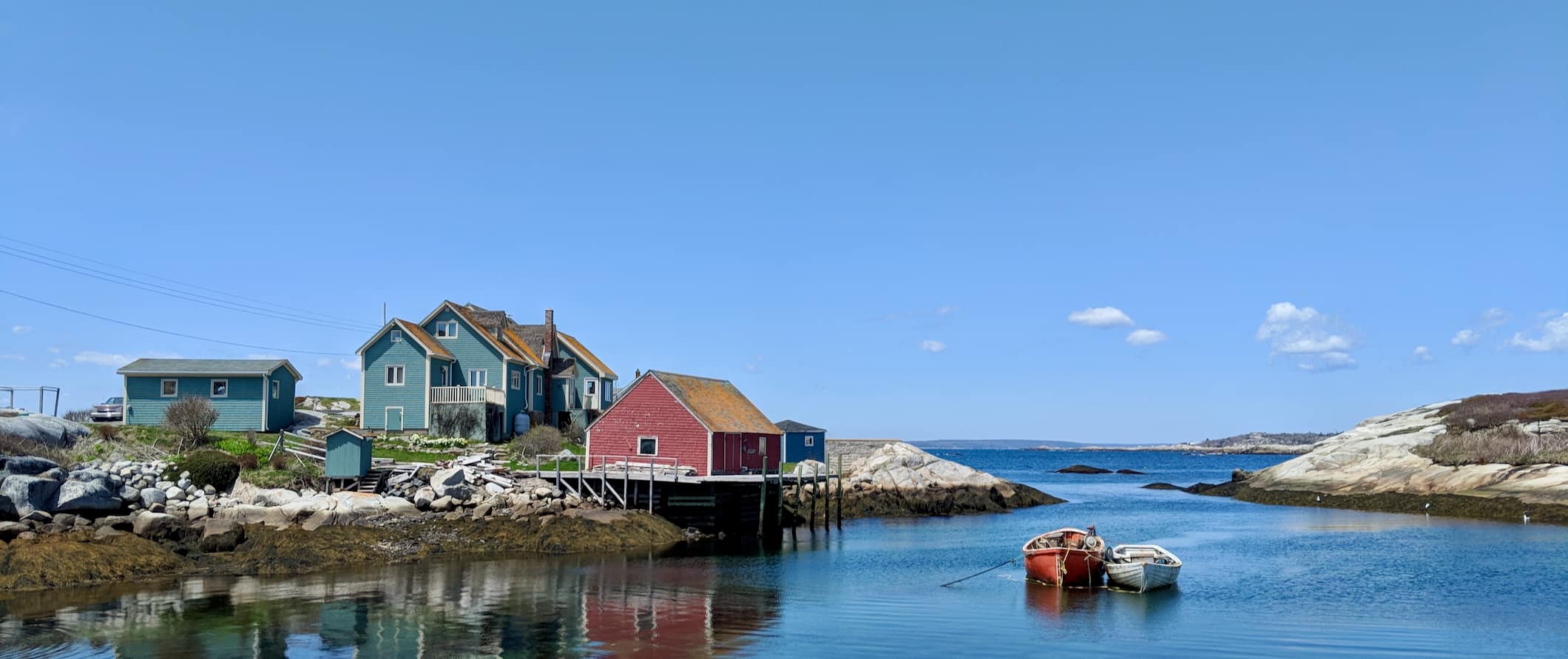
Public transportation – Halifax is the only major urban center in Nova Scotia and locals depend on a public bus system to get around. Halifax’s public buses can take you all around the inner city and into the suburbs, but the downtown area is very walkable. Fares are 2.75 CAD.
You can take the MetroX bus from the airport to downtown St. John’s for 4.25 CAD (exact change required). There’s also a ferry connecting downtown Halifax to Dartmouth for 2.75 CAD.
Bus – Taking the bus is the best way to get around Nova Scotia if you don’t have a car. Maritime Bus connects most towns in the province. A two-hour trip from Halifax to Lunenburg is 26 CAD, while Halifax to Mahone Bay takes an hour and costs 20.25 CAD. Halifax to Sydney (Cape Breton) costs 72 CAD and takes 6 hours.
To find bus routes and prices, use BusBud .
Taxi – Taxis are not cheap here. Their base rate is 3.75 CAD, and it’s an additional 1.70 CAD per kilometer afterward. Prices add up fast so I’d avoid them if you can.
Ridesharing – Uber is available in Halifax, but the city is easily walkable so I’d skip the ridesharing if you can.
Car Rental – Car rentals can be found for as little as 30 CAD per day for a multi-day rental. If you want to take advantage of all that Nova Scotia has to offer, this is your best option. For the best car rental prices, use Discover Cars .
When to Go to Nova Scotia
Nova Scotia is at its busiest in the summer, with the best weather occurring between June and August. Temperatures often exceed 25°C (78°F). Keep in mind that accommodation prices are higher during this time, but tourist attractions are never overly crowded compared to elsewhere in Canada.
Both early fall and late spring are also excellent times to visit. The weather is warm, you can do all the outdoor exploration you want, and the tourist season isn’t in full swing. This is the best time to drive Cape Breton’s Cabot Trail. The fall colors are particularly pretty.
Winters in Nova Scotia are cold and wet, with temperatures ranging between from -17-0°C (0-32°F) from December to March. If you come during this time, be prepared for all weather types and dress in layers because it is cold. Keep in mind that many businesses shut down for the winter (mostly outside of Halifax). In short, I’d avoid a winter visit unless you’re here for winter sports and activities.
How to Stay Safe in Nova Scotia
You don’t have to worry much about crime in Nova Scotia — it’s incredibly safe to visit. Your greatest risk is petty crime like pickpocketing, but even that is super rare. Overall, I really wouldn’t worry about crime here. Getting hurt hiking is more likely to happen than any crime!
Like much of rural Canada, Nova Scotia has ticks that carry Lyme Disease. If you’re hiking, try to wear long sleeves or pants, or stick to well-trodden trails. Check yourself for ticks after spending time in nature.
Solo female travelers should generally feel safe here. However, the standard precautions you take anywhere apply (never leave your drink unattended at the bar, never walk home alone intoxicated, etc.). For more information, check out one of the many solo female travel blogs in the city.
If you’re visiting in the winter, make sure you keep an eye on the weather — especially if you’re driving a car. Road conditions can change rapidly.
Hurricanes can occasionally make it up to the Maritimes, so keep an eye on them if you’re visiting during hurricane season (June-November).
If you experience an emergency, dial 911 for assistance.
When in doubt, always trust your instincts. If a taxi driver seems shady, get out. If your hotel or accommodation is seedier than you thought, go somewhere else. Make copies of your personal documents, including your passport and ID, in case of an emergency.
The most important piece of advice I can offer is to purchase good travel insurance. Travel insurance will protect you against illness, injury, theft, and cancellations. It’s comprehensive protection in case anything goes wrong. I never go on a trip without it as I’ve had to use it many times in the past.
Nova Scotia Travel Guide: The Best Booking Resources
These are my favorite companies to use when I travel. They consistently have the best deals, offer world-class customer service and great value, and overall, are better than their competitors. They are the companies I use the most and are always the starting point in my search for travel deals.
- Skyscanner – Skyscanner is my favorite flight search engine. They search small websites and budget airlines that larger search sites tend to miss. They are hands down the number one place to start.
- Hostelworld – This is the best hostel accommodation site out there with the largest inventory, best search interface, and widest availability.
- Booking.com – The best all around booking site that constantly provides the cheapest and lowest rates. They have the widest selection of budget accommodation. In all my tests, they’ve always had the cheapest rates out of all the booking websites.
- Get Your Guide – Get Your Guide is a huge online marketplace for tours and excursions. They have tons of tour options available in cities all around the world, including everything from cooking classes, walking tours, street art lessons, and more!
- SafetyWing – Safety Wing offers convenient and affordable plans tailored to digital nomads and long-term travelers. They have cheap monthly plans, great customer service, and an easy-to-use claims process that makes it perfect for those on the road.
- LifeStraw – My go-to company for reusable water bottles with built-in filters so you can ensure your drinking water is always clean and safe.
- Unbound Merino – They make lightweight, durable, easy-to-clean travel clothing.
- Top Travel Credit Cards – Points are the best way to cut down travel expenses. Here’s my favorite point earning credit cards so you can get free travel!
Nova Scotia Travel Guide: Related Articles
Want more info? Check out all the articles I’ve written on backpacking/traveling Canada and continue planning your trip:
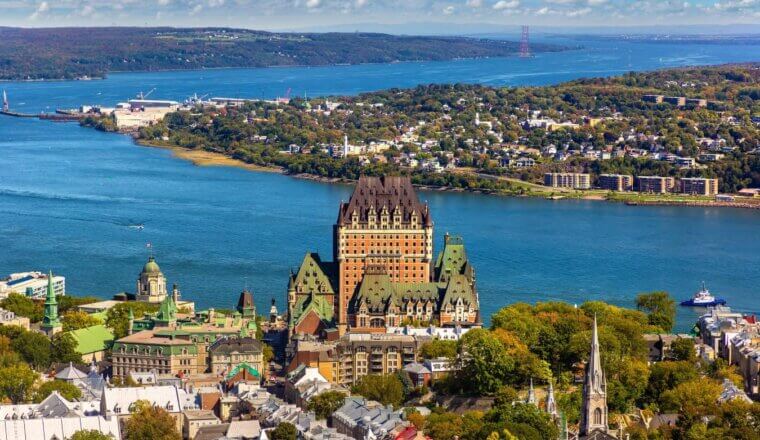
Where to Stay in Quebec City: The Best Neighborhoods for Your Visit

Where to Stay in Vancouver: The Best Neighborhoods for Your Visit

Where to Stay in Toronto: The Best Neighborhoods for Your Visit
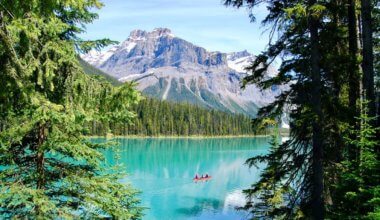
Canada Road Trip: A One Month Suggested Itinerary
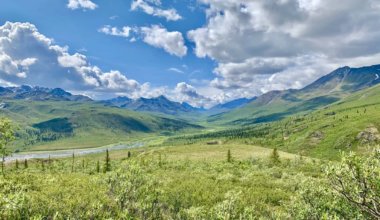
How to Road Trip the Yukon on a Budget
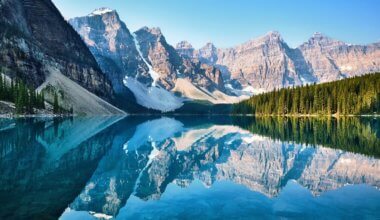
How to See Alberta: A 10-Day Suggested Driving Itinerary
Get my best stuff sent straight to you, pin it on pinterest.
- Where To Stay
- Transportation
- Booking Resources
- Related Blogs

Halifax Visitor Guide
Use the guide to get inspired and plan your next halifax adventure., halifax kids' guide, order guides and maps.
Order the Halifax Visitor Guide , the Halifax Kids’ Guide , or the Halifax Urban Walking Map to help you plan your trip.
Bulk order Visitor Guides and Maps for a business or event
Halifax Visitor Guides

Welcome to Halifax
P'jilita'q wla kjipuktuk.

Halifax is in Mi’kma’ki, the ancestral and unceded territory of the Mi’kmaq people. The people of the Mi’kmaw Nation have lived on this territory for millennia, and we acknowledge them as the past, present and future caretakers of this land. Historically, a land acknowledgment is a traditional practice shared amongst Indigenous groups to recognize the Indigenous land and territory they are visiting. Today a land acknowledgement remains a way to express one’s gratitude to the Indigenous people for being stewards of the land that we live and work on.
Privacy Overview

IMAGES
COMMENTS
Find all the helpful info you need to plan your visit to Nova Scotia, Canada. Discover the top things to see and do, along with unique experiences.
Discover where to go and what to do on your next Nova Scotia adventure when you download a copy of our annual Doers and Dreamers travel guide. This comprehensive planning tool comes complete with contact information, accommodation details, and top attractions and experiences. From time to time, we ask travellers to participate in follow-up ...
Learn about our culture, how to travel to and within Nova Scotia, what the weather will be like during the time of year you plan to visit, and much, much more. Travel Info | Tourism Nova Scotia, Canada
Nova Scotia is located in easternmost Canada ( upper east coast of North America ), and is one of four Atlantic Provinces. Almost completely surrounded by the Atlantic Ocean, "Canada's Ocean Playground" offers plenty of coastline to explore, including the World Famous Bay of Fundy. Discover Nova Scotia's must-see signature attractions including ...
Delivered in partnership between Tourism Nova Scotia and Digital Nova Scotia, DigiPort is an online resource centre where you can connect with qualified digital service providers for one-on-one support and access articles, videos, tip sheets, webinars and more to help you be more visible online, reach more potential customers, and close the sale.
Visit Nova Scotia's official tourism site; Order a travel guide; Destinations, Festivals, Events. Things to see and do; Festivals and Events; Museums; Parks (provincial) How to get here. How to get to Nova Scotia; Find a place to stay. Places to stay
Discover the stories and history of Nova Scotia at museums, historic and UNESCO sites, stroll through incredible and aromatic gardens, explore our coastal heritage and marvel at the incredibly talented artists and artisans who continue to be inspired by our scenic landscapes and life by the sea. Put yourself in the centre of the action by attending one of our many festivals & events that ...
I need more Information. Download your free Nova Scotia Travel Guide by clicking here. For more information please call: 1-800-565-0000 (within North America). If you are outside of North America, please call 1-902-425-5781, or Email: [email protected].
Nova Scotia. Facing the wild swells of the Atlantic, Nova Scotia is heavily influenced by the sea. With its candy-striped lighthouses, salty fishing towns and towering red cliffs, this Maritime province feels thrillingly rugged and wild, especially in winter, when storms thrash the coastline and the ocean freezes.
The fortress Louisbourg is one of the best places to visit in Nova Scotia - a recreation of a French fort. Other places to visit in Cape Breton include the Glace Bay Miners Museum, the town of Sydney, Goat Island - and of course, the world-famous Cabot Trail. 9. Wolfville and the Annapolis Valley.
4. Cruise the Cabot Trail. Undeniably, one of the best things to do in Nova Scotia is to drive the Cabot Trail. The trail navigates a 185-mile (298-kilometer) loop around most of Cape Breton Island, weaving throughout Cape Breton Highlands National Park.
Location: Cape Breton Island, Nova Scotia. 2. Peggy's Cove. Peggy's Cove. About 43 kilometers southwest of Halifax, the fishing village of Peggy's Cove has a back-in-time feel. Peggy's Point Lighthouse, one of Canada's most photographed lighthouses, sits on the foggy Atlantic Coast marking a perilous point.
There's no question the hardest part about your visit to Nova Scotia is deciding what to do next. Make the most of your time by exploring our Top 25 things to see and do in Nova Scotia... with a little off-the-beaten-path adventure mixed in.
Nova Scotia. Nova Scotia is one of Canada 's Atlantic Provinces. With around 950,000 inhabitants, it is one of the least populated. For visitors, Nova Scotia offers beaches, history, rugged wilderness parks, a mix of Celtic, Acadian French, and Indigenous cultures.
These rankings are informed by traveler reviews—we consider the quality, quantity, recency, consistency of reviews, and the number of page views over time. 2023. 1. Halifax Public Gardens. 4,109. Gardens. Welcome to Halifax's greatest natural and national treasure and most visited site in Halifax, Nova Scotia- a timeless oasis in an ever ...
There's something about this place that captivates all who visit. Cape Breton Island tells its story through rugged cliffs and the trails that crisscross its landscape, in the languages of its people, and through the music and dance celebrating centuries of culture. Here, the profound history of Unama'ki—its true name and the ancestral ...
Get information on Nova Scotia Travel Guide - Expert Picks for your Vacation hotels, restaurants, entertainment, shopping, sightseeing, and activities. Read the Fodor's reviews, or post your own.
Check the Tourism Nova Scotia website for more info! Go camping - If you want to camp, use novascotia.goingtocamp.com to find available campsites around the province. A two-person site costs around 27-35 CAD. Look for the happy hours - The Ultimate Happy Hours website lists all the happy hour drink and food specials around Halifax. They ...
Downtown Halifax is essentially built into the side of a steep hill, and overlooking it all is the Halifax Citadel National Historic Site. This star-shaped fortress overlooks the city and once protected a young Halifax from attack by land and sea. At 12pm listen for the daily cannon fire, known locally as the "noon gun".
They provide travellers with outstanding service, helping to make their travel planning easy and seamless, and inspiring more people to come to Nova Scotia. The Tourism Contact Centre can be reached at our toll-free number, 1-800-565-0000 and via e-mail at [email protected].
Order the Halifax Visitor Guide, the Halifax Kids' Guide, or the Halifax Urban Walking Map to help you plan your trip. Bulk order Visitor Guides and Maps for a business or event. Halifax Visitor Guide 2024. Halifax Kids' Guide 2024. Halifax Visitor Guide 2023. Halifax Kids' Guide 2023. Halifax Visitor Guide 2022. Halifax Kids' Guide 2022.